|
|
Six Flags Great America – Gurnee, Illinois
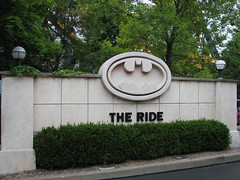 A dialectic runs through my head over whether or not I think Batman is one of B&M’s finest inverted coasters, or simply a scaled-back practice outing that they would later refine and build upon. One part of me (we’ll say it’s my right brain) keeps saying, “Of course it is! This is by far the tightest design they ever made for an inverted coaster, back before they became too dependent on force readouts and still made coasters with some kick to them. Everything else after this design was compromised by taller heights and faster speeds… ergo, more controlled forces and slower timing between elements. It might be small and short, but it’s non-stop and packs the most aggressive punch Bolliger & Mabillard has ever made – or will ever make.” A dialectic runs through my head over whether or not I think Batman is one of B&M’s finest inverted coasters, or simply a scaled-back practice outing that they would later refine and build upon. One part of me (we’ll say it’s my right brain) keeps saying, “Of course it is! This is by far the tightest design they ever made for an inverted coaster, back before they became too dependent on force readouts and still made coasters with some kick to them. Everything else after this design was compromised by taller heights and faster speeds… ergo, more controlled forces and slower timing between elements. It might be small and short, but it’s non-stop and packs the most aggressive punch Bolliger & Mabillard has ever made – or will ever make.”
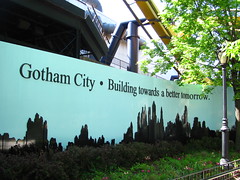 But then the other half of my brain (the left hemisphere) chimes in, “Don’t get too sentimental. While the design of the elements might be tight, that’s only to be canceled out by the extra-small scale and speed. The ride time is short as well, and while it might not be a bad coaster, there are plenty of other inverts built after it that are much more ambitious. The only reason it’s been duplicated so many times is because it’s small, cheap and easily accessible for lazy parks that don’t feel like taking any risks with their design.” But then the other half of my brain (the left hemisphere) chimes in, “Don’t get too sentimental. While the design of the elements might be tight, that’s only to be canceled out by the extra-small scale and speed. The ride time is short as well, and while it might not be a bad coaster, there are plenty of other inverts built after it that are much more ambitious. The only reason it’s been duplicated so many times is because it’s small, cheap and easily accessible for lazy parks that don’t feel like taking any risks with their design.”
I have more sympathy towards the right hemisphere of my brain, since the left’s argument basically boils down to “bigger is better; clones are bad”, which can easily be defeated. That said, I’ve been on my fair share of Batmen before and my impression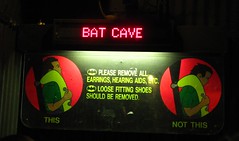 still seems stuck at the phase where I need to ride it more to decide how much I really enjoy it. Not helping is the fact that I can usually only ride it once or twice a year, and the simple struggle it usually is to survive a day in a Six Flags park, with all the long lines and dehydration that normally entails. But if right is right I should have a stronger opinion of the coaster by now, so maybe my left brain is correct and I’m simply transferring my sentimentality for other pre-1998 B&M coasters onto this design. Maybe what I need is a good old fashioned ride analysis written miles away from the nearest working example settle my internal debate. still seems stuck at the phase where I need to ride it more to decide how much I really enjoy it. Not helping is the fact that I can usually only ride it once or twice a year, and the simple struggle it usually is to survive a day in a Six Flags park, with all the long lines and dehydration that normally entails. But if right is right I should have a stronger opinion of the coaster by now, so maybe my left brain is correct and I’m simply transferring my sentimentality for other pre-1998 B&M coasters onto this design. Maybe what I need is a good old fashioned ride analysis written miles away from the nearest working example settle my internal debate.
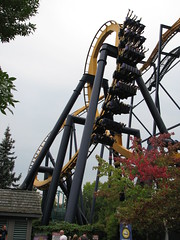 Imagine, if I will… I’m in the front row, ascending the lift; we reach the crest and skirt down the pre-drop before sharply twisting around and down. The narrow radius twisting is cool. I haven’t quite had anything like that on a B&M coaster in a while, but I’m also struck by how short this drop is, pulling up what looks like twenty feet above ground-level when it’s already not much more than 100ft. tall. The first loop is tight and intense, but it also seems to just blow through it fast without providing as much dizzyingly quick fore-and-aft rotation I was expecting. What that means is, picture yourself doing a front-flip on a bungee trampoline: flipping around Imagine, if I will… I’m in the front row, ascending the lift; we reach the crest and skirt down the pre-drop before sharply twisting around and down. The narrow radius twisting is cool. I haven’t quite had anything like that on a B&M coaster in a while, but I’m also struck by how short this drop is, pulling up what looks like twenty feet above ground-level when it’s already not much more than 100ft. tall. The first loop is tight and intense, but it also seems to just blow through it fast without providing as much dizzyingly quick fore-and-aft rotation I was expecting. What that means is, picture yourself doing a front-flip on a bungee trampoline: flipping around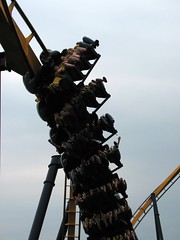 your axis in one second will feel much more intense than if it takes three, even though there’s no added g-forces involved between either scenarios. your axis in one second will feel much more intense than if it takes three, even though there’s no added g-forces involved between either scenarios.
We pull up, into the zero-g roll (this was the first ever built). Again, in terms of timing it’s very quick, but I still seem to be missing the tight angular momentum. The rolling movement is much more sudden on this than on later versions where they would lead into it more on the incline. There’s also a bit of a ‘snap’ to the roll at the inverting point with an almost imperceptible shimmy to the right, adding a bit extra unpredictability and intensity. Wasting no time, we’re diving back down to set up vertical loop number two, basically a carbon copy of the first The rolling movement is much more sudden on this than on later versions where they would lead into it more on the incline. There’s also a bit of a ‘snap’ to the roll at the inverting point with an almost imperceptible shimmy to the right, adding a bit extra unpredictability and intensity. Wasting no time, we’re diving back down to set up vertical loop number two, basically a carbon copy of the first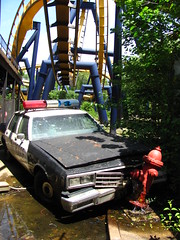 and provides not much in the way of new sensations, but creates a solid, forward-moving loop/roll/loop progression that constitutes the first half of the experience before it switches into the banked turn heavy second half that’s constantly doubling back over and around itself. and provides not much in the way of new sensations, but creates a solid, forward-moving loop/roll/loop progression that constitutes the first half of the experience before it switches into the banked turn heavy second half that’s constantly doubling back over and around itself.
We slide hard around an upward left helix that diminishes in force. There’s no midcourse brake run on the ride, but in some ways it still nearly feels like it because the high altitude transition from left to right acts as half a placeholder. It’s alright though, because this is one of the best places on the ride to appreciate the feet dangling invertedness (which is particularly important if the year is 1992) and it has a bit of a crescendo at the end as we dive to the right, almost like a second first drop, into the first flat-spin. It whips us around to the right without losing momentum before diving into a trench and continuing up into the second corkscrewing flat-spin. This combo of inversion/turn/inversion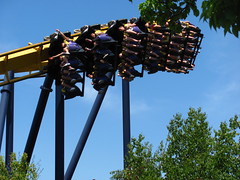 neatly mirrors the first loop/roll/loop progression that was on the opposite side of the slow elevated midpoint, and is easily the nimblest moment of our bat-vehicles. The final left turn starts out with some vigor but finishes weak, a last second denouement of sorts so the brake run that comes less than 40 seconds after cresting the lift doesn’t feel so unexpected. neatly mirrors the first loop/roll/loop progression that was on the opposite side of the slow elevated midpoint, and is easily the nimblest moment of our bat-vehicles. The final left turn starts out with some vigor but finishes weak, a last second denouement of sorts so the brake run that comes less than 40 seconds after cresting the lift doesn’t feel so unexpected.
However, at the end of each of these rides my right brain had to make a few concessions to my left brain; that while the quick timing between elements is there, by itself that doesn’t accomplish as much as I wish it could. I was hard-pressed to feel much extra force or rotational quickness from the extra small elements. They were simply that: extra small. In many ways the ride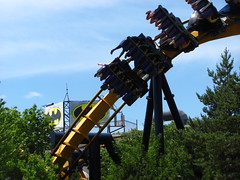 reminds me perfectly of a mini-Raptor, with similar element sequencing and a two-part progression separated by an airy mid-act, but smaller, slower and done sooner. That’s hardly a bad thing. It’s just I couldn’t find anything in its smallness to elevate it above the larger counterparts, it’s only a lesser brother to those rides. reminds me perfectly of a mini-Raptor, with similar element sequencing and a two-part progression separated by an airy mid-act, but smaller, slower and done sooner. That’s hardly a bad thing. It’s just I couldn’t find anything in its smallness to elevate it above the larger counterparts, it’s only a lesser brother to those rides.
I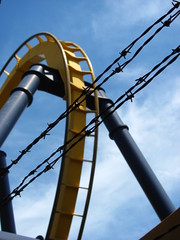 n defense, I’m not a local to any Six Flags park, and I’ve read more than one report from people who are about how their local Batman ride used to go so fast on a hot summer night it looked physically dangerous from off-ride. I’ve never had one of those rides so I can’t comment, but as long as someone qualifies that they did get to experience it when it was running that fast I wouldn’t have a problem if they claim Batman one of B&M’s best. There’s more that can make a great coaster than fast pacing and forcefulness, but if it’s really strong in both of those categories that already is more that can be said than many others. The best thing that I can say about Batman is that at least it’s a consistent ride from beginning to end, with no half-assed helices or s-curves thrown in just to pad out the ending. This is a ride that knows what you want and gives you exactly that with nothing deluxe sprinkled on the top. n defense, I’m not a local to any Six Flags park, and I’ve read more than one report from people who are about how their local Batman ride used to go so fast on a hot summer night it looked physically dangerous from off-ride. I’ve never had one of those rides so I can’t comment, but as long as someone qualifies that they did get to experience it when it was running that fast I wouldn’t have a problem if they claim Batman one of B&M’s best. There’s more that can make a great coaster than fast pacing and forcefulness, but if it’s really strong in both of those categories that already is more that can be said than many others. The best thing that I can say about Batman is that at least it’s a consistent ride from beginning to end, with no half-assed helices or s-curves thrown in just to pad out the ending. This is a ride that knows what you want and gives you exactly that with nothing deluxe sprinkled on the top.
An added feature that I really liked about Six Flags Great America’s version is there are some close calls with nearby trees and shrubs. Particularly on the descent down into the first corkscrew and immediately after the second corkscrew on the final turn, the plant life nearly enfolds the trains on all sides. Someone tall enough might even be able to kick some of the branches if they really reach for it. I don’t believe any other Batman layout has anything quite as confrontational; combined with the more natural setting that fits with the park, I think this first Batman probably is the best of all the versions ever manufactured since its debut in 1992. More than twenty years later it’s still possibly the best looping coaster in the Chicago area. That has to count for something.
Valencia, California
Some people may find what I am about to say disturbing. Children and those with weak constitutions should leave the webpage immediately. Roller Coaster Philosophy bears no responsibility for any psychological damage the following piece of information may cause. Be absolutely certain you understand the risks involved before you read the next line. Last chance. Are you ready? Brace yourself.
Déjà Vu was closed the entire weekend.
 Shocking, I know. A ride built a decade ago still can’t operate like a normal coaster. Granted, it may have been for a normally scheduled off-season rehab, but Six Flags posts no rehab schedules so it’s hard to be certain. Experiencing Déjà Vu has become a notoriously rare and privileging event, like witnessing a total eclipse. I can count three Giant Inverted Boomerang encounters in my lifetime (out of a total of six visits to parks with a GIB on property), two of which were on the same day back in 2002 on this very model, an unknown motivation possessing us to wait in another three-hour queue well after midnight after we had already done it once that morning. I guess it was because they are indeed quite fun rides, with the extended weightlessness on both of the vertical towers mixed between the rapid-fire giant inversions, Shocking, I know. A ride built a decade ago still can’t operate like a normal coaster. Granted, it may have been for a normally scheduled off-season rehab, but Six Flags posts no rehab schedules so it’s hard to be certain. Experiencing Déjà Vu has become a notoriously rare and privileging event, like witnessing a total eclipse. I can count three Giant Inverted Boomerang encounters in my lifetime (out of a total of six visits to parks with a GIB on property), two of which were on the same day back in 2002 on this very model, an unknown motivation possessing us to wait in another three-hour queue well after midnight after we had already done it once that morning. I guess it was because they are indeed quite fun rides, with the extended weightlessness on both of the vertical towers mixed between the rapid-fire giant inversions,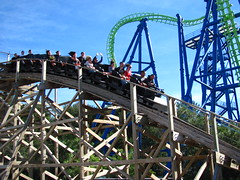 a delectable club sandwich of tower-loops-tower-loops-tower (though that last ‘tower’ is a bit soft and soggy). From 2002 I mostly remember standing in a cattle corral while the ride repeatedly broke down, the rest of the park long-since emptied, waiting behind three guys who could evidently speak seven different languages to impress the ladies. Happy memories. While Vekoma got a B+ in the design of a fun compact layout, they got a D- for their market research. The rides are too big and complicated for a small park to purchase new off the lot, but too low capacity to meet the daily demand needs for any large regional park like Six Flags… and apparently too prone to downtime for any potential buyer to consider keeping in the long run, deep-pocketed or not. a delectable club sandwich of tower-loops-tower-loops-tower (though that last ‘tower’ is a bit soft and soggy). From 2002 I mostly remember standing in a cattle corral while the ride repeatedly broke down, the rest of the park long-since emptied, waiting behind three guys who could evidently speak seven different languages to impress the ladies. Happy memories. While Vekoma got a B+ in the design of a fun compact layout, they got a D- for their market research. The rides are too big and complicated for a small park to purchase new off the lot, but too low capacity to meet the daily demand needs for any large regional park like Six Flags… and apparently too prone to downtime for any potential buyer to consider keeping in the long run, deep-pocketed or not.
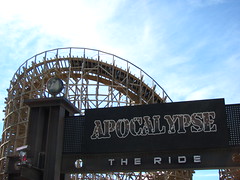 In all honesty I could hardly be bothered by this closure when there was a far better attraction worthy of my time mere paces away. Originally opening as Terminator Salvation: The Ride, the rechristened Apocalypse has been hailed by many as one of the best roller coaster Great Coasters Intl. has built to date. Then again, it seems every ride GCI constructs has people declaring on internet message boards that they have found GCI’s best-ever, so I generally hold off on ranking their coasters until I’ve ridden myself, as it looks a tad unprofessional place every contender as #1. And to be honest, I was always more skeptical towards Apocalypse than I was toward Great Coaster’s other recent layouts. Not that I doubted it would be a very good ride, indeed I figured it would be one of the park’s attractions worth devoting the largest share In all honesty I could hardly be bothered by this closure when there was a far better attraction worthy of my time mere paces away. Originally opening as Terminator Salvation: The Ride, the rechristened Apocalypse has been hailed by many as one of the best roller coaster Great Coasters Intl. has built to date. Then again, it seems every ride GCI constructs has people declaring on internet message boards that they have found GCI’s best-ever, so I generally hold off on ranking their coasters until I’ve ridden myself, as it looks a tad unprofessional place every contender as #1. And to be honest, I was always more skeptical towards Apocalypse than I was toward Great Coaster’s other recent layouts. Not that I doubted it would be a very good ride, indeed I figured it would be one of the park’s attractions worth devoting the largest share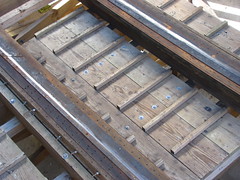 of my time on before I ever arrived in Los Angeles. But the combination of it being pretty short by wooden coaster standards and having a kind of ugly appearance sent up a few red flags. Apocalypse’s 2877 feet is about a garden hose longer than the Raven, a layout notorious for proving bigger isn’t always better and has had more than one newbie enthusiast return to the station asking “is that all there is?” And I really don’t care for the aesthetics of the coaster from the midway. The layout is constricted to fill an oddly shaped lot resulting in almost no discernable pattern or organization, and visually it’s all inward-facing fan turns against the midway shutting spectators off from the action, a far cry from the formal eloquence of the Hersheypark Wildcat’s open, swooping curves. It seems the better GCI gets at designing an on-board ride experience of my time on before I ever arrived in Los Angeles. But the combination of it being pretty short by wooden coaster standards and having a kind of ugly appearance sent up a few red flags. Apocalypse’s 2877 feet is about a garden hose longer than the Raven, a layout notorious for proving bigger isn’t always better and has had more than one newbie enthusiast return to the station asking “is that all there is?” And I really don’t care for the aesthetics of the coaster from the midway. The layout is constricted to fill an oddly shaped lot resulting in almost no discernable pattern or organization, and visually it’s all inward-facing fan turns against the midway shutting spectators off from the action, a far cry from the formal eloquence of the Hersheypark Wildcat’s open, swooping curves. It seems the better GCI gets at designing an on-board ride experience the worse they are at the off-ride experience, so hopefully this observation from the entrance will ultimately work to the ride’s advantage. the worse they are at the off-ride experience, so hopefully this observation from the entrance will ultimately work to the ride’s advantage.
Not helping was the fact that a coaster not even two years old had already been significantly altered from its intended vision. Apocalypse is the perfect example of why I hate franchise tie-ins and special effects to sell a new ride, because you know the park is going to be a tightwad a few years down the road, refusing to renew their license for an old, second-rate blockbuster, nor maintain their effects. You’re left with a new ride that feels like a has-been before it had a full chance to-be. Even if they’ve adjusted the theme from the Former State Governor to a generic End of the World storyline, every enthusiast and local will continue to swap stories about “this used to be the Terminator coaster” for the foreseeable future, and we’ve got a flame thrower that never sparks and heavy audio components in each car with metal plates bolted over. Though I suppose the worse that can be said about all of this is it annoys the particularly obsessive enthusiasts and curbs the capacity slightly with the disused audio-box still taking the place of the twelfth car. I’ll stop being one of those obsessive enthusiassses now (at least as much as I can not be) will continue to swap stories about “this used to be the Terminator coaster” for the foreseeable future, and we’ve got a flame thrower that never sparks and heavy audio components in each car with metal plates bolted over. Though I suppose the worse that can be said about all of this is it annoys the particularly obsessive enthusiasts and curbs the capacity slightly with the disused audio-box still taking the place of the twelfth car. I’ll stop being one of those obsessive enthusiassses now (at least as much as I can not be)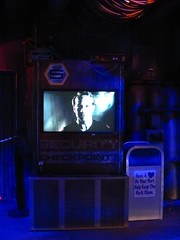 and focus on other insignificant details. and focus on other insignificant details.
The preshow consists of a series of three themed rooms, although there’s only one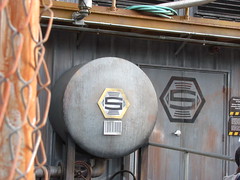 effect shared between the three of these rooms and they all involve watching television monitors explain the back-story to us. There’s never an explained cause of the apocalypse, although I could conjecture that the obliterated environment was a result of low-rent Los Angeles actors having recently chewed through all the scenery. First we’re introduced to the Good Guys (you can tell because they act very Solemn And Important) and then in the next room effect shared between the three of these rooms and they all involve watching television monitors explain the back-story to us. There’s never an explained cause of the apocalypse, although I could conjecture that the obliterated environment was a result of low-rent Los Angeles actors having recently chewed through all the scenery. First we’re introduced to the Good Guys (you can tell because they act very Solemn And Important) and then in the next room to the Bad Guys (you can tell because they act like they’re actually having some fun, admittedly a foreign and dangerous concept to Six Flags), and then in the third room they kick each other’s asses for a bit… and while this battle for civilization is being fought, me and a couple of other wiseacres are nonchalantly trying to adjust our positions nearer to the exit door so we can get the good seats first. Preshows can be a good idea on crowded days because they essentially absorb part of what would otherwise be part of the queue, but on days like today it just meant a lot more seats were sent out empty while we were stuck waiting behind closed doors. to the Bad Guys (you can tell because they act like they’re actually having some fun, admittedly a foreign and dangerous concept to Six Flags), and then in the third room they kick each other’s asses for a bit… and while this battle for civilization is being fought, me and a couple of other wiseacres are nonchalantly trying to adjust our positions nearer to the exit door so we can get the good seats first. Preshows can be a good idea on crowded days because they essentially absorb part of what would otherwise be part of the queue, but on days like today it just meant a lot more seats were sent out empty while we were stuck waiting behind closed doors.
This actually worked to my advantage, as on the first afternoon I was able to get six rides in a row without getting off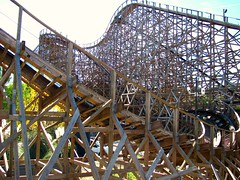 (including twice in the front seat!), because every time we returned to the station I found that all the airgates were empty as people were still stuck waiting for the last preshow to finish. The station flythough is sort of wasted on this coaster because everyone loads directly onto the train after finishing the showrooms, and it’s partly blocked from view anyway so the room just gets a bit loud for a second while I’m buckling the seatbelts, and I pause to wonder where that sound came from as it surely wasn’t from the on-board audio anymore. The ride ops – who clearly do not take the preshow videos as seriously as the actors do – bid us brave settlers farewell as our 11-seater Millennium Flyer train rolls into the (including twice in the front seat!), because every time we returned to the station I found that all the airgates were empty as people were still stuck waiting for the last preshow to finish. The station flythough is sort of wasted on this coaster because everyone loads directly onto the train after finishing the showrooms, and it’s partly blocked from view anyway so the room just gets a bit loud for a second while I’m buckling the seatbelts, and I pause to wonder where that sound came from as it surely wasn’t from the on-board audio anymore. The ride ops – who clearly do not take the preshow videos as seriously as the actors do – bid us brave settlers farewell as our 11-seater Millennium Flyer train rolls into the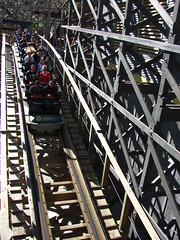 prelift dips and hops before ascending the 95’ climb. prelift dips and hops before ascending the 95’ climb.
The Rye Aeroplane Coaster beginnings (which, like Kentucky Rumbler, doesn’t quite get the Aeroplane right due to GCI softening their curves and transitions too much) drops riders into a veritable tunnel of supports and headchoppers buried under the lift hill dramatically increasing the sense of speed, tossing us right into a high speed ejector bunny hop before rising into a large fan turn with a double dip exit. Six Flags even manages to bring something to the table with the inclusion of a tunnel on the second fan turn buried under the lift, the reverberating noise and sudden change in light levels keeping minds alert while the body granted a reprieve from the constant changing dynamics. This is followed by another fast s-curve to set up the station fly-through,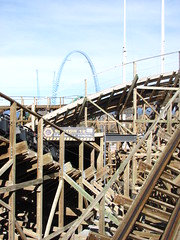 which feels like a tunnel. Retinas are flooded with daylight again for only a split second before diving into a third tunnel, the strobe between dark, light and dark bearing favorable comparisons to Tremors or Voyage. which feels like a tunnel. Retinas are flooded with daylight again for only a split second before diving into a third tunnel, the strobe between dark, light and dark bearing favorable comparisons to Tremors or Voyage.
This sequence, which comprises about two thirds of the overall layout, is all golden GCI, especially the sequence from the first drop to the double dip. I’ve heard a few people claim they dislike GCI as they feel over-engineered and don’t get many laterals, which I suppose is true but I don’t mind it too much as they replace laterals with high rotation contrasts, and they know how to set a coaster to a beat. Even when the sequence is pretty much random, their rides always feel organic and natural as wood coasters to me (opposed to some of the Gravity Group’s faux aggressiveness mixed with B&M style parabolas and banking techniques) and nothing strikes as being out of place or of missed potential, pretty much a consequence of their improvisatory nature.
 As soon as Apocalypse emerges from the second tunnel, it morphs into a very different ride than from the first two thirds, in my opinion to the detriment of the overall experience. There’s suddenly a long, high-speed right turnaround that abandons the direction changes of the first half and therefore halts the beat, which could have been an effective middle bridge if there was anything of interest on the other side. Unfortunately there is only one more direction change, this time an elevated flat left turn that doesn’t even have the advantage of good pacing. Then it’s the final brakes. This last one-third constitutes the weakest and most strikingly out-of-character finale I’ve ever come across in a GCI layout, undoubtedly a product of being ordered to fill the entirety of a lot while needing to build around queue switchbacks and preshow rooms As soon as Apocalypse emerges from the second tunnel, it morphs into a very different ride than from the first two thirds, in my opinion to the detriment of the overall experience. There’s suddenly a long, high-speed right turnaround that abandons the direction changes of the first half and therefore halts the beat, which could have been an effective middle bridge if there was anything of interest on the other side. Unfortunately there is only one more direction change, this time an elevated flat left turn that doesn’t even have the advantage of good pacing. Then it’s the final brakes. This last one-third constitutes the weakest and most strikingly out-of-character finale I’ve ever come across in a GCI layout, undoubtedly a product of being ordered to fill the entirety of a lot while needing to build around queue switchbacks and preshow rooms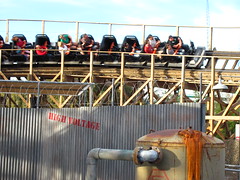 rather than as part of any deliberate creative design. That’s the disadvantage of a light-footed, improvised rather than as part of any deliberate creative design. That’s the disadvantage of a light-footed, improvised approach to layout configuration: sooner or later the last ad-lib might become boxed into a corner, inventing a set-up with no punch-line. The slow elevated helix finale on Tatsu is resolution, on Apocalypse it is dissolution. Though perhaps the disappointing conclusion was just cleverly upholding the spirit of the original blockbuster theme. approach to layout configuration: sooner or later the last ad-lib might become boxed into a corner, inventing a set-up with no punch-line. The slow elevated helix finale on Tatsu is resolution, on Apocalypse it is dissolution. Though perhaps the disappointing conclusion was just cleverly upholding the spirit of the original blockbuster theme.
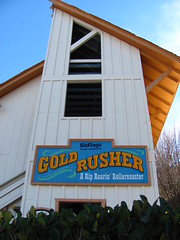 Around the next corner is Magic Mountain’s original roller coaster, recently completing 40 years of service, the Gold Rusher. You could certainly do worse as far as early-era Arrow Dynamic mine trains, this one markedly benefitting from the abundance of uneven topography. The entire layout up to the second lift hill follows perfectly the contours of the land, with nearly all of the crossties built directly on the ground. There’s a funky S-curve double dip off the first chain lift I like (partially enclosed beneath Superman’s plaza), although following this there’s only a brief helix skirting over a pond before stopping again for the second chain lift. This takes us even higher up the mountain, gaining enough altitude that we stop tracing the ground and start flying through the canopies instead. Much more substantial than the first ‘half’, we get a few more wandering switchbacks mixed with the odd block brake sections before wrapping it up with a rousing downhill double helix, the sort of element that’s gentle by today’s standards but can still be more satisfying than on bigger rides if only because it has a clear sense of finality to the layout. Around the next corner is Magic Mountain’s original roller coaster, recently completing 40 years of service, the Gold Rusher. You could certainly do worse as far as early-era Arrow Dynamic mine trains, this one markedly benefitting from the abundance of uneven topography. The entire layout up to the second lift hill follows perfectly the contours of the land, with nearly all of the crossties built directly on the ground. There’s a funky S-curve double dip off the first chain lift I like (partially enclosed beneath Superman’s plaza), although following this there’s only a brief helix skirting over a pond before stopping again for the second chain lift. This takes us even higher up the mountain, gaining enough altitude that we stop tracing the ground and start flying through the canopies instead. Much more substantial than the first ‘half’, we get a few more wandering switchbacks mixed with the odd block brake sections before wrapping it up with a rousing downhill double helix, the sort of element that’s gentle by today’s standards but can still be more satisfying than on bigger rides if only because it has a clear sense of finality to the layout.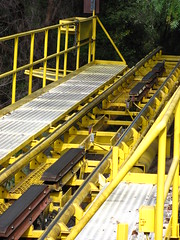 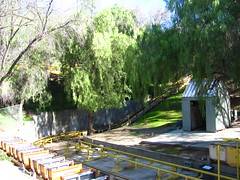
Perhaps most delightful about the Gold Rusher (at least for nerds, which if you’re reading this far I assume probably describes you) were some of the eccentric engineering touches not found on any other mine trains I’ve seen. The double tubular spine/support system eschews the traditional wooden structure and allows for a more brightly colored yellow appearance than the normal dark browns and grays. Kicker tires are present along the brakes, a feature not included on any of the other wholly gravity and chain driven Arrow Dynamic coasters, and most curious of all, the traditional pinch brakes found on all other steel coasters are absent in favor of under-friction skid brakes.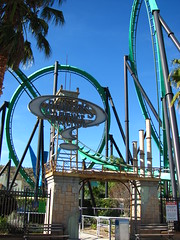 Must be something different about California. Must be something different about California.
Just a short walk down the midway one will find a towering green and black structure that belongs to Riddler’s Revenge, the 1998 B&M stand-up coaster that generally seems to rank as the de facto best stand-up coaster ever built, not that it’s all that well liked of a genre to begin with. Most people seem to dismiss stand-up coasters as an unnecessary gimmick that tends to only make rough, groin-flattening experiences of an otherwise decent layout. I’m a bit more optimistic towards these coasters than that, not only because I’m adept at riding the ‘proper’ way and haven’t found the usual worst offenders to be intolerably rough (Mantis, Iron Wolf, etc.) The stand-up position also allows for a higher center of gravity, and with the greater vertical displacement the body becomes a far more sensitive instrument to detecting forces and rotation. Since B&M aren’t exactly known for designing highly dynamic, aggressive rides, I tend to view this as a good thing at least for those who prefer more extreme sensations from their coasters.
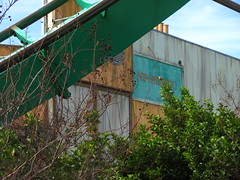 The entrance is not inside the Gotham City area like one would expect but is instead off the main midway, the ride presentation a half-breed of the old Warner Brother’s themed attention to detail like on the original Batmen, and the Premier Parks styling of gigantic flat lot coasters with cattle corral queues and shoebox stations. Once inside, the station is nicely presented as Edward Nigma’s lab with a custom theme song (who makes those for thrill rides anymore?), a techno-beat track with a layer of almost flamenco-sounding guitar that will take almost anyone back to the late 90’s regardless of if you had gone to Magic Mountain then or not. You’ll be listening to it for a lot longer if you want a row towards the front of the train, because the station is designed with the entrance in the rear where all the lines for the individual rows The entrance is not inside the Gotham City area like one would expect but is instead off the main midway, the ride presentation a half-breed of the old Warner Brother’s themed attention to detail like on the original Batmen, and the Premier Parks styling of gigantic flat lot coasters with cattle corral queues and shoebox stations. Once inside, the station is nicely presented as Edward Nigma’s lab with a custom theme song (who makes those for thrill rides anymore?), a techno-beat track with a layer of almost flamenco-sounding guitar that will take almost anyone back to the late 90’s regardless of if you had gone to Magic Mountain then or not. You’ll be listening to it for a lot longer if you want a row towards the front of the train, because the station is designed with the entrance in the rear where all the lines for the individual rows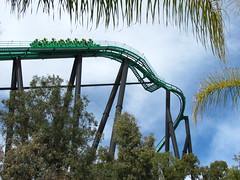 cut diagonally across to, so that the queue for the last car can barely contain four people while for the front you’ll be waiting probably about eight to ten dispatches for if full. Despite single-train operation it’s not too busy and most of the rows are close to equal, so I take the front. cut diagonally across to, so that the queue for the last car can barely contain four people while for the front you’ll be waiting probably about eight to ten dispatches for if full. Despite single-train operation it’s not too busy and most of the rows are close to equal, so I take the front.
The layout is derived from 1997’s Chang, which itself was derived from 1996’s Mantis, each time getting negligibly taller and faster and with one more inversion. However, I personally think each iteration was a regression, not an improvement. The only improved aspect of the Riddler’s layout I can find is the placement of the vertical loop around the lift hill, which makes for a nice visual especially from the beginning of the lift. The first drop profile is different, substituting the elevated dipped curve and straight drop with a twisting banked plunge. This is really the less extreme approach as it maneuvers into the downgrade via a banked sideways rotation with an inward curvature (and thus constant positive G-forces) the entire way down, rather than the outward curvature and weightlessness that takes advantage of the sensitive stand-up position.
Although on the surface each ride appears to boast an ‘extra’ inversion from the last, the reality is that the layouts aren’t necessarily longer or more complicated, they just removed a non-inverting element from the previous design and inserted a loop in its place. I prefer the non-inverting elements, particularly the inclined helix over the station on Mantis and Chang over Riddler’s wholly redundant second dive loop. The helices had a greater variety of force and pacing with the S-curve entrance and variable banking on the exit, while the dive loop is a much blander maneuver with a uniform G-force,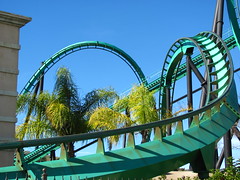 and it’s basically a copy of the element we got just a moment before. The inclined loop is still a cool treat despite the elimination of the banking wobble on the incline (why was this maneuver exclusive to the mega-stand-ups?), and there’s a quick change in pace with the banked curve before the midcourse, even though it’s missing the fast left-to-right transition with the pop of airtime in the middle. Then there’s the post midcourse brake run finale, which takes after Chang with the two corkscrews rather than Mantis with the tight figure-eight finale. Rather than demonstrate and it’s basically a copy of the element we got just a moment before. The inclined loop is still a cool treat despite the elimination of the banking wobble on the incline (why was this maneuver exclusive to the mega-stand-ups?), and there’s a quick change in pace with the banked curve before the midcourse, even though it’s missing the fast left-to-right transition with the pop of airtime in the middle. Then there’s the post midcourse brake run finale, which takes after Chang with the two corkscrews rather than Mantis with the tight figure-eight finale. Rather than demonstrate their articulated vehicle’s versatility with sharp but smooth banking transitions that constantly keep one guessing, the Revenge decides to slow the pace way down with a long, meandering second half that lazily creeps around back to the first drop, turning around and keeping one guessing only in as far as wondering when the second corkscrew will appear to liven things up. Sorry, I’m not trying to be a Debbie Downer with this comparison, I’m just calling it the way I see the respective layouts and I’m perplexed why Mantis always gets all the hate while Riddler is assumed to be the superior ride without the need for much or any justification. Is it just that Riddler’s Revenge tracks smoother than Mantis (only by a little bit for me), or is there something else I’m missing? their articulated vehicle’s versatility with sharp but smooth banking transitions that constantly keep one guessing, the Revenge decides to slow the pace way down with a long, meandering second half that lazily creeps around back to the first drop, turning around and keeping one guessing only in as far as wondering when the second corkscrew will appear to liven things up. Sorry, I’m not trying to be a Debbie Downer with this comparison, I’m just calling it the way I see the respective layouts and I’m perplexed why Mantis always gets all the hate while Riddler is assumed to be the superior ride without the need for much or any justification. Is it just that Riddler’s Revenge tracks smoother than Mantis (only by a little bit for me), or is there something else I’m missing?
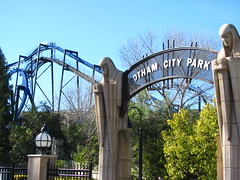  Down the block in Gotham City proper, sporting a fresh black and blue paint scheme, is Batman: The Ride. I remember the days when Batman used to be considered hot shit. Apart from some alterations to the original props and effects in the queue and station, the roller coaster today is about as good as it ever was back in 1994, but it has gotten lost amid the newer giants of the past decade. Down the block in Gotham City proper, sporting a fresh black and blue paint scheme, is Batman: The Ride. I remember the days when Batman used to be considered hot shit. Apart from some alterations to the original props and effects in the queue and station, the roller coaster today is about as good as it ever was back in 1994, but it has gotten lost amid the newer giants of the past decade.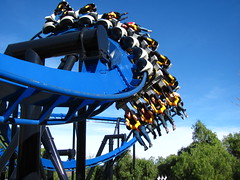 Its demure stature at only 105’ makes it easily overlooked when surveying the thrill ride landscape of Magic Mountain, and as the third of twelve clones worldwide Its demure stature at only 105’ makes it easily overlooked when surveying the thrill ride landscape of Magic Mountain, and as the third of twelve clones worldwide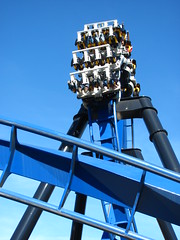 it’s understandable why this B&M invert tends to go unnoticed until one’s tour around the park brings it directly into their sightline. There should be no call for recognition, there is no need to rediscover a lost gem. I’ve been on many of the others and I knew what to expect from this one. There are no surprises. Nothing original would be learned. I would walk away from Batman wholly unchanged as a person. Obscurity suits The Ride well, like its namesake you shouldn’t be able to see it until you really need it. Lurking at the back of Gotham City Park, with two-train operation an empty queue is guaranteed for a day like today, and given the liberal attitude towards rerides the next half hour of my life would yield exceptionally pleasant, which I don’t think possible had I arrived in this moment with any prior anticipation. it’s understandable why this B&M invert tends to go unnoticed until one’s tour around the park brings it directly into their sightline. There should be no call for recognition, there is no need to rediscover a lost gem. I’ve been on many of the others and I knew what to expect from this one. There are no surprises. Nothing original would be learned. I would walk away from Batman wholly unchanged as a person. Obscurity suits The Ride well, like its namesake you shouldn’t be able to see it until you really need it. Lurking at the back of Gotham City Park, with two-train operation an empty queue is guaranteed for a day like today, and given the liberal attitude towards rerides the next half hour of my life would yield exceptionally pleasant, which I don’t think possible had I arrived in this moment with any prior anticipation.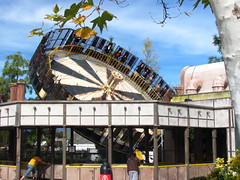
Everything I’d have to say about the merits and shortcomings of the roller coaster itself are already covered in my review of the original installation at Six Flags Great America. The good pacing is there, as is the short ride length, and the forces aren’t as strong on a day with partially loaded trains as some proponents of the make claim is possible. The desert environment isn’t as effective as Great America’s narrow calls with ponds and foliage, however the foreground mini-world of Gotham City is about as extravagant as any you’ll find at Six Flags. An entire city block is re-created, distancing itself from the midway setting that every other Batman ride is built along, and sporting a couple of complimentary (but ultimately negligible) flat rides. Immersive, sort of, 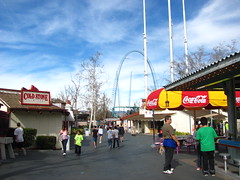 but only because a decaying metropolis is a well-suited theme for Six Flags, in which a normal trashy and stained look is only for the better. but only because a decaying metropolis is a well-suited theme for Six Flags, in which a normal trashy and stained look is only for the better.
Which brings me to Scream!. Everything I said in praise about Magic Mountain’s shiny, Hollywood aesthetics in part one, I must retract at this point in the review. (Don’t worry; you’ll get it back in part three.) The entire back midway of the park from Cyclone Bay to Scream (excluding the Gotham City add-on, but including parts of Samurai Summit) is a depressing corridor in need of revitalization. Maybe moving in the right direction with the transformation into the DC Universe I was a bit too early to witness. The biggest strike against it is that it’s mostly flatlands and lacking in the same density of vegetation found elsewhere in the park, and that there’s an abundance of games and food shops that are never in use or completely shut down. This non-theme continues right back to 2003’s B&M Medusa clone, a ride carefully assembled to have as little disruption to the pre-existing environment as possible. and that there’s an abundance of games and food shops that are never in use or completely shut down. This non-theme continues right back to 2003’s B&M Medusa clone, a ride carefully assembled to have as little disruption to the pre-existing environment as possible.
The faded, splotchy paint in look-at-meeee blue, magenta and yellow, the overly obvious name, the exclamation points and visually busy banners that only serve to emphasize the vicinity’s lifelessness, the awkward midway connecting point causing a stagnant cul-de-sac, the concentration camp queue leading into a square tin station, and all those lines… those fucking white parking lines everywhere. Scream is a time-portal into the early 2000’s, a glimpse back into the recent history at harsher,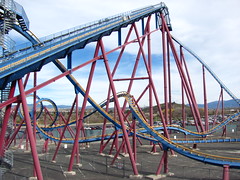 bleaker times. A time when massive capital projects were plopped down without plan or reason in an attempt to quickly inflate a stock price; a reminder to count our blessings today and to remain hopeful and optimistic towards the future. Only Six Flags under Premier Park management could install a 150’ tall seven inversion B&M floorless coaster that becomes seen as a liability against the park’s reputation; or at the very best, a benign multi-million dollar asset. I recall all those shitty teenage memories spent on Six Flags property (mostly in endless queues) near the turn of the millennium… and then I am reminded that at its core this would be a headlining attraction at nearly any other amusement park on earth, and I am granted the supreme luxury of being able to look down my nose at such a ride. bleaker times. A time when massive capital projects were plopped down without plan or reason in an attempt to quickly inflate a stock price; a reminder to count our blessings today and to remain hopeful and optimistic towards the future. Only Six Flags under Premier Park management could install a 150’ tall seven inversion B&M floorless coaster that becomes seen as a liability against the park’s reputation; or at the very best, a benign multi-million dollar asset. I recall all those shitty teenage memories spent on Six Flags property (mostly in endless queues) near the turn of the millennium… and then I am reminded that at its core this would be a headlining attraction at nearly any other amusement park on earth, and I am granted the supreme luxury of being able to look down my nose at such a ride.
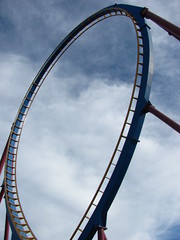 Luckily for Scream, I might be one of its harsher critics, and there are folks more willing to see past its superficial ugliness to the mathematical Swiss beauty that lay within. Among these were my riding companions, a mom-and-son team of local enthusiasts, the younger member of the duo recognizing my iSpeed t-shirt and a subsequent conversation couldn’t have been a lovelier way to pass the time waiting for a front row credit check on one train operation; particularly lovely when I found a mention of my website was met with some recognition! Even with such fine company I was still one to disagree with such an assessment, as supposing the setting in Tivoli Gardens I would nevertheless find it a rather dull, unimaginative sequence of poorly-paced inversions, the textbook example of B&M relying on formula and simply going through the motions. And it’s a bit rough. Not that I mind being beat up by coasters as there are plenty rougher within a mile radius that I would heap praise upon, but when you’ve got a track designed to neutralize as much as possible any unusual force in its aerobatics, the vibromatic seats becomes all that much more a defining feature in the overall ride experience. Luckily for Scream, I might be one of its harsher critics, and there are folks more willing to see past its superficial ugliness to the mathematical Swiss beauty that lay within. Among these were my riding companions, a mom-and-son team of local enthusiasts, the younger member of the duo recognizing my iSpeed t-shirt and a subsequent conversation couldn’t have been a lovelier way to pass the time waiting for a front row credit check on one train operation; particularly lovely when I found a mention of my website was met with some recognition! Even with such fine company I was still one to disagree with such an assessment, as supposing the setting in Tivoli Gardens I would nevertheless find it a rather dull, unimaginative sequence of poorly-paced inversions, the textbook example of B&M relying on formula and simply going through the motions. And it’s a bit rough. Not that I mind being beat up by coasters as there are plenty rougher within a mile radius that I would heap praise upon, but when you’ve got a track designed to neutralize as much as possible any unusual force in its aerobatics, the vibromatic seats becomes all that much more a defining feature in the overall ride experience.
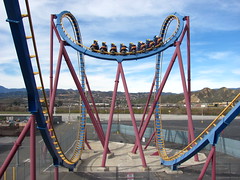 As I walked down the exit staircase, bidding goodbye to new friends while determining that a second ride would not be in the cards for me, I decided that if ever there was a candidate for Six Flags’ ride rotation program for a chance to start a new life with a different identity on a blank slate (not literally over blank slate, of course), it should be Scream. There’s the potential for something in it, maybe, but today I could only see the million dollar waste pile of material and human capital by a few people with no imagination. Leaving the Mardi Gras Monstrosity behind, I faced the theme park once again alone. The world’s largest collection of thrill rides was at my fingertips, and no one was there to tell me where to step next. So, now which way does the wind blow? As I walked down the exit staircase, bidding goodbye to new friends while determining that a second ride would not be in the cards for me, I decided that if ever there was a candidate for Six Flags’ ride rotation program for a chance to start a new life with a different identity on a blank slate (not literally over blank slate, of course), it should be Scream. There’s the potential for something in it, maybe, but today I could only see the million dollar waste pile of material and human capital by a few people with no imagination. Leaving the Mardi Gras Monstrosity behind, I faced the theme park once again alone. The world’s largest collection of thrill rides was at my fingertips, and no one was there to tell me where to step next. So, now which way does the wind blow?
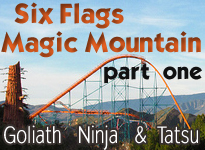 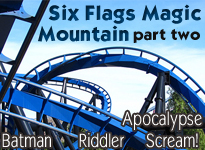 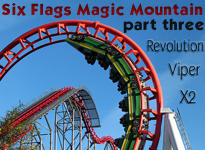
Six Flags Great America – Gurnee, Illinois
Batman: The Ride
 A dialectic runs through my head over whether or not I think Batman is one of B&M’s finest inverted coasters, or simply a scaled-back practice outing that they would later refine and build upon. One part of me (we’ll say it’s my right brain) keeps saying, “Of course it is! This is by far their tightest design ever made for an inverted coaster, back before they became too dependent on force readouts and still made coasters with some kick to them. Everything else after this design was compromised by taller heights and faster speeds… ergo, more controlled forces and slower timing between elements. It might be small and short, but it’s non-stop and packs one of the most aggressive punches Bolliger & Mabillard ever have – or will – pull.” A dialectic runs through my head over whether or not I think Batman is one of B&M’s finest inverted coasters, or simply a scaled-back practice outing that they would later refine and build upon. One part of me (we’ll say it’s my right brain) keeps saying, “Of course it is! This is by far their tightest design ever made for an inverted coaster, back before they became too dependent on force readouts and still made coasters with some kick to them. Everything else after this design was compromised by taller heights and faster speeds… ergo, more controlled forces and slower timing between elements. It might be small and short, but it’s non-stop and packs one of the most aggressive punches Bolliger & Mabillard ever have – or will – pull.”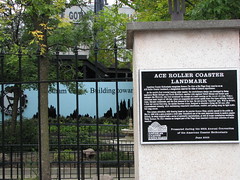
But then the other half of my brain (the left hemisphere) chimes in, “Don’t get too sentimental. While the design of the elements might be tight, that’s only to be canceled out by the extra-small scale and speed. The ride time is short as well, and while it might not be a bad coaster, there are plenty of other inverts built after it that are much more ambitious. The only reason it’s been duplicated so many times is because it’s small, cheap and easily accessible for lazy parks that don’t feel like taking any risks with their design.”
I have more sympathy towards the right hemisphere of my brain, since the left’s argument basically boils down to “bigger is better; clones are bad”, which can easily be defeated. That said, I’ve been on my fair share of Batmen before (Magic Mountain, Over Georgia, Great Adventure, and Illinois’ own original), and out of my one or two rides on each of those park visits I was never able to glean much from those prior experiences, which I would partially attribute to the simple struggle to survive a day in a Six Flags park, with all the long lines and dehydration that normally entails. But I should have a stronger opinion of the coaster by now, so maybe my left brain is correct, and I’m simply transferring my sentimentality for other pre-1998 B&M coasters onto this design. Crowds aren’t too bad, and even still I have a Flash Pass in my pocket, so today should be a good day to settle this debate. That said, I’ve been on my fair share of Batmen before (Magic Mountain, Over Georgia, Great Adventure, and Illinois’ own original), and out of my one or two rides on each of those park visits I was never able to glean much from those prior experiences, which I would partially attribute to the simple struggle to survive a day in a Six Flags park, with all the long lines and dehydration that normally entails. But I should have a stronger opinion of the coaster by now, so maybe my left brain is correct, and I’m simply transferring my sentimentality for other pre-1998 B&M coasters onto this design. Crowds aren’t too bad, and even still I have a Flash Pass in my pocket, so today should be a good day to settle this debate.
First major ride of the day after Ragin’ Cajun, in the front row, ascending the lift; we reach the crest and skirt down the pre-drop before sharply twisting around and down. The tight twisting is quite cool, haven’t quite had anything like that on a B&M coaster in a while, but I’m also struck by how short this drop is, pulling up what looks like twenty feet above ground-level when it’s already not much more than 100ft. tall. The first loop is tight and intense, but it also seems to just blow through it really fast rather than provide the dizzyingly quick fore-and-aft rotational forces I was expecting. What that means is, picture yourself doing a front-flip on a bungee trampoline: flipping around your axis in one second will feel much more intense than if it takes three, even though there’s technically no added g-forces involved between either scenarios. in the front row, ascending the lift; we reach the crest and skirt down the pre-drop before sharply twisting around and down. The tight twisting is quite cool, haven’t quite had anything like that on a B&M coaster in a while, but I’m also struck by how short this drop is, pulling up what looks like twenty feet above ground-level when it’s already not much more than 100ft. tall. The first loop is tight and intense, but it also seems to just blow through it really fast rather than provide the dizzyingly quick fore-and-aft rotational forces I was expecting. What that means is, picture yourself doing a front-flip on a bungee trampoline: flipping around your axis in one second will feel much more intense than if it takes three, even though there’s technically no added g-forces involved between either scenarios.
We pull up, into the zero-g roll (this was the first ever built). Again, in terms of timing it’s very quick, but I still seem to be missing the tight rotational g-forces. The rolling movement is much more sudden on this than on later versions where they would lead into it more on the incline. There’s also a bit of a ‘snap’ to the roll right at the inverting point, adding a bit extra unpredictability and intensity. Wasting no time, we’re diving back down to set up vertical loop number two, basically a carbon copy of the first and provides not much in the way of new sensations, but creates a nice, all straight-forward loop/roll/loop progression that constitutes the first half of the experience before it switches into the turn-based second half.
We slide hard around an upward left helix diminishes in force. There’s no midcourse brake run on the ride, but in some ways it still nearly feels like it because the high above the ground transition from left to right curve acts as half a placeholder. It’s alright though,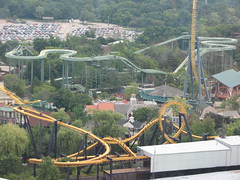 because this is one of the best places on the ride to appreciate the inverted set-up (particularly important if the year is 1992) and we get a good build-up as we dive to the right, almost like a second first drop, into the first flat-spin. We tightly whip around to the right without losing momentum before diving into a trench and continuing up into the second corkscrewing flat-spin. This combo of inversion/turn/inversion neatly mirrors the first loop/roll/loop progression that was on the opposite side of the high turn transition midpoint, and is also easily the most nimble the train gets. The final left turn starts out with some vigor but finishes weak as a denouement of sorts so the brake run that comes less than 40 seconds after cresting the lift doesn’t feel so unexpected. because this is one of the best places on the ride to appreciate the inverted set-up (particularly important if the year is 1992) and we get a good build-up as we dive to the right, almost like a second first drop, into the first flat-spin. We tightly whip around to the right without losing momentum before diving into a trench and continuing up into the second corkscrewing flat-spin. This combo of inversion/turn/inversion neatly mirrors the first loop/roll/loop progression that was on the opposite side of the high turn transition midpoint, and is also easily the most nimble the train gets. The final left turn starts out with some vigor but finishes weak as a denouement of sorts so the brake run that comes less than 40 seconds after cresting the lift doesn’t feel so unexpected.
However, at the end of each of these rides, my right brain had to make a few concessions to my left brain; that while the quick timing between elements is there, by itself that doesn’t accomplish as much as I wish it could. I was hard-pressed to feel much extra rotational intensity from the extra-small elements, they were simply that: extra small. In many ways the ride reminds me perfectly of a mini-Raptor, with similar element sequencing and progression, just smaller, slower and over quicker. That’s hardly a bad thing, as Batman is still a great ride. It’s just I couldn’t find anything in its smallness to elevate it above the larger counterparts such as Raptor, it’s only a lesser brother to those rides.
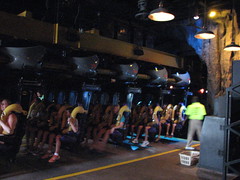 Now, I’m not going to declare anything definitive just yet, because my experiences came mostly from morning rides on a cool day, so the fact that the ride paced even comparably to Raptor is quite amazing. I’ve heard reports from people about how their local Batman ride used to go so fast on a hot summer night it looked physically dangerous from off-ride. I didn’t get those rides, so I can’t comment, but as long as someone qualifies that they did get to experience it when it was running that fast I wouldn’t have a problem if they claim it one of B&M’s best. Now, I’m not going to declare anything definitive just yet, because my experiences came mostly from morning rides on a cool day, so the fact that the ride paced even comparably to Raptor is quite amazing. I’ve heard reports from people about how their local Batman ride used to go so fast on a hot summer night it looked physically dangerous from off-ride. I didn’t get those rides, so I can’t comment, but as long as someone qualifies that they did get to experience it when it was running that fast I wouldn’t have a problem if they claim it one of B&M’s best.
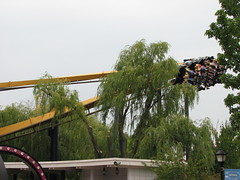 An added feature that I really liked about Six Flags Great America’s version is in the second half there were some extremely close calls with nearby trees and shrubs. Particularly on the descent down into the first corkscrew and immediately after the second on the final turn, the plant life nearly completely enfolds the trains on all sides, not only heightening the sense of speed but just making for an astonishing visual effect. Someone tall enough might even be able to kick some of the branches if they really reach for it. I don’t believe any other Batman layout has anything quite as confrontational; combined with the more natural setting that fits with the park, I think this first Batman probably is the best of all the versions ever manufactured since it’s debut. An added feature that I really liked about Six Flags Great America’s version is in the second half there were some extremely close calls with nearby trees and shrubs. Particularly on the descent down into the first corkscrew and immediately after the second on the final turn, the plant life nearly completely enfolds the trains on all sides, not only heightening the sense of speed but just making for an astonishing visual effect. Someone tall enough might even be able to kick some of the branches if they really reach for it. I don’t believe any other Batman layout has anything quite as confrontational; combined with the more natural setting that fits with the park, I think this first Batman probably is the best of all the versions ever manufactured since it’s debut.
Superman: Ultimate Flight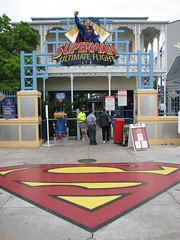
The park’s other inverted superhero themed coaster in many ways recalls its predecessor while in other ways offering the completely opposite experience. Batman is gritty and intense and based on quick variations in the layout, while Superman is graceful and slower paced, based on creating a singular flight sensation, and quite honestly it’s all a tad boring. It’s probably no surprise then that most enthusiasts (myself included) would take Batman over Superman any day of the week. That said there is more to justify the “Superman Experience” than I originally would have admitted, but what’s there still isn’t quite enough to justify any two-hour waits. I speak from experience, as the longest I ever waited for a roller coaster was this ride back in 2005 at nearly three and a half hours (there might have been longer lines in Millennium Force’s opening year but I can’t recall the specifics).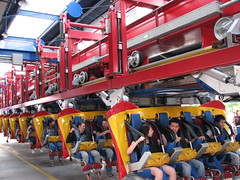
Also, Superman nearly justifies the expense of the Flash Pass all by itself. The queue is pretty much always the longest in the park, and the ride is the lowest capacity in the park except for the wild mice and maybe the Whizzer, although Superman is probably tied for popularity with Raging Bull so it’s a much larger draw. The merge point is right up in the station, so you can skip by a couple hours’ long wait in about a minute (minus the time waiting for your reservation time, however, but I’m fairly confident the actual queue length was longer than the 50 minutes our Flash Pass made us wait before boarding).
The flying experience really transforms the ride experience in more ways than one might at first anticipate. Pretty much every g-force you feel is redirected by 90 degrees, creating new directional forces we rarely if ever get to experience on a coaster, i.e. forward and backward forces are normally only felt on launches and brake runs; maybe spinning coasters. In none of those situations are the g-forces derived from gravitational conflicts either, giving a unique vocabulary to the styles of sensations on this coaster.
On the other hand I’ve still not been entirely sold on the ‘flying’ as a valid one. The main reason is that when we imagine what it would feel like to free-fly, zero-gravity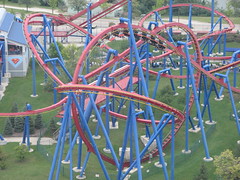 is generally assumed. That’s obviously not possible to sustain, so with the constant pull of gravity experienced that fairly well kills any real flying sensation, and that’s not including the restrictive restraints in the equation. Actually they are quite comfortable, but the fact is resting on your chest is not a very natural way to ride the coaster. is generally assumed. That’s obviously not possible to sustain, so with the constant pull of gravity experienced that fairly well kills any real flying sensation, and that’s not including the restrictive restraints in the equation. Actually they are quite comfortable, but the fact is resting on your chest is not a very natural way to ride the coaster.
Then there’s the layout. Maybe it’s just me but if I could fly like Superman, I wouldn’t zig-zag over the same cleared field, I’d go places, over and under things, stuff like that. Every seat has an unrestricted view, and yet the park doesn’t capitalize on this at all, the uniform mowed lawn it’s built on only broken up by the same blue supports and the occasional queue line that everyone wonders if someone will throw up on them as they pass overhead.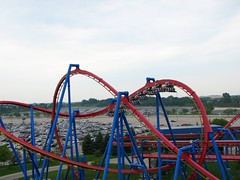
Also, in terms of progression, it’s rather awkward. The initial pretzel loop easily stands alone as a completely unique defining moment of the ride. The dynamics are unlike anything else, so when it comes right at the beginning of the layout it makes the rest of the coaster look boring by contrast. Airtime at the top, strong positives at the bottom (and remember these are all skewed by 90 degress so it’s a particularly wacky brand of airtime as it presses forward on your chest instead of up from underneath), plus the rapidly changing orientation to the ground that has us in a kamikaze dive upside down… it’s a great element, probably the most impressive single maneuver inside Great America’s gates.
 After that, layout, elements, pacing and progression all get shoved out the door in favor of a somewhat idyllic series of turns that don’t accomplish anything other than give a unified sensation of flying for several seconds. After that, layout, elements, pacing and progression all get shoved out the door in favor of a somewhat idyllic series of turns that don’t accomplish anything other than give a unified sensation of flying for several seconds. From a designer’s perspective, this track is pretty simple; I was looking at it from the station and realized most of the curves were based on simple geometric shapes and parabolic contours, nothing more advanced or intricate, with very long transitions. This section of the ride is over rather quickly as well, only about 22 seconds before the free-flight is over and we’re wrapping it up with the final inline roll into the brakes. From a designer’s perspective, this track is pretty simple; I was looking at it from the station and realized most of the curves were based on simple geometric shapes and parabolic contours, nothing more advanced or intricate, with very long transitions. This section of the ride is over rather quickly as well, only about 22 seconds before the free-flight is over and we’re wrapping it up with the final inline roll into the brakes.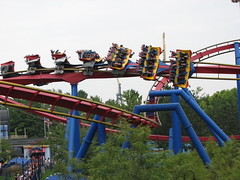
By the way, here’s an interesting debate I’m not sure I’ve ever seen had: does this final roll count as an inversion? By most accounts, yes, the track clearly rotates a complete 360 degrees. But what about from the rider’s perspective? They’re never held heels over head, their body length is always kept parallel to the ground, it just rotates around the front axis. Something fundamental about the nature of an ‘inversion’ seems to be denied with that. Yet it also would seem absurd to not call it an inversion, when the track is shaped nearly identical to other heartline rolls and in-line twists on standard, upright coasters, so why should those elemental properties change just when a particular train design is on them instead? Food for thought…
Iron Wolf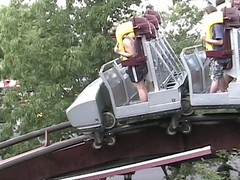
This was my favorite ride back in 2005. I suspect its unpopularity with the rest of the park guests (resulting in by far the shortest lines of the day) had something to do with it. But I also liked the layout of the coaster much more, and I never had any problems with roughness or head banging. It’s a tight, curved based layout that’s deceptively longer than it looks, and despite being a compact B&M coaster, it’s old enough that the trees around it have grown in really well and almost feels like a terrain coasters at times in the second half. While some people saw stand-up trains as a gimmick that rightfully needed to die before the turn of the millennium, I personally feel that they add a considerable amount to the ride experience, not that I’d like many more coasters to have them.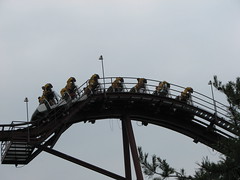 The body is much more vulnerable to g-forces making the ride more intense, and stretching our center of gravity up higher and affected by a longer span produces some interesting dynamics not experienced on sit-down coasters; as you go around a loop or over a drop on one of these things, recall that concept of torque from your high school physics class… The body is much more vulnerable to g-forces making the ride more intense, and stretching our center of gravity up higher and affected by a longer span produces some interesting dynamics not experienced on sit-down coasters; as you go around a loop or over a drop on one of these things, recall that concept of torque from your high school physics class…
There’s also the roughness that a lot of people take issue with. I hear this about a lot of coasters, and I don’t understand much of any of it. When I hear people flaming a coaster in online message boards about how it cracked their spine in two and caused cranial hemorrhaging, and then I ride it and don’t have any problems whatsoever, I have been led to believe one of three conclusions:
1): That I am very lucky that I always get to ride rough coasters on their one ‘good’ day out of the year.
2): That most enthusiast’s skeletal structures are made out of Crispix.
3): That I am a masochist without realizing it.
While generally I like to believe hypothesis #2, after my five rides in a row on Iron Wolf that day (yes, in a row…) and being generally pulverized by the restraints and bad shuffling in the wheel assemblies on each and every cycle, I might have to consider #3 more carefully in the future.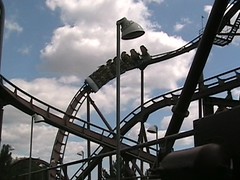
It wasn’t this rough back in 2005, which is a shame because the added roughness did diminish my enjoyment of the ride considerably. It was worst on the first drop, some of the curving dives in the first half, and the corkscrew, and generally much stronger in the back rows and on the edges; my one ride in the front and center row was by far the smoothest. Yet as I confessed, I still went around and did it four more times throughout the day knowing full well what I was in store for.
Maybe it was just that I knew how to brace for it properly, so as I was subjected to all the jostling I was able to avoid taking any ‘fatal blows’, allowing me to climb off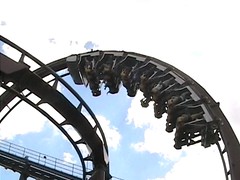 it in perfect condition but weary of all the work I had to put in to stay that way, which is a better adrenaline rush and scare factor than all the uber-controlled coasters that try to feign intimidation, i.e. Top Thrill Dragster and the like. it in perfect condition but weary of all the work I had to put in to stay that way, which is a better adrenaline rush and scare factor than all the uber-controlled coasters that try to feign intimidation, i.e. Top Thrill Dragster and the like.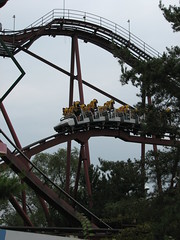
And it’s still a good layout, altering between slower, more graceful moments I could let my guard down, and faster, more intense moments I had to physically and psychologically prepare for lest I get the crap beat out of me. In terms of layout, it’s probably my favorite of all the early B&M stand-ups, much more convoluted and with hidden layers of twists and turns in the finale, overall a stronger emphasis on multitudes of direction changes and a complex layout than later designs that started splitting the coasters up into fewer ‘big moment’ elements. Plus, as I mentioned, the surroundings add a lot too, with plenty of trees that perfectly fit the ride theme, a sort of symbiotic mix between the rustic and the industrial. Although I was still relieved whenever we finally got to the brake run.
Iron Wolf probably has its days numbered, especially with the rumors that Six Flags Kentucky Kingdom’s Chang will be relocated here in 2011. That’s appropriate, since the ride is a bit too small for the park these days, and that back corner needs some revitalization as hardly anyone makes it back there anymore. Besides, I’d hate to see the stand-up concept leave the park after all this time, so it’s a fitting upgrade. And Iron Wolf should be relocated to another park in the chain, since while 1990 might seem ancient for a B&M coaster, it’s still quite young compared to other steel coasters that have been relocated, and would make a great fit at a place like Six Flags Mexico, Six Flags America or some other park that needs a new steel coaster but doesn’t have a complete budget for one.
Raging Bull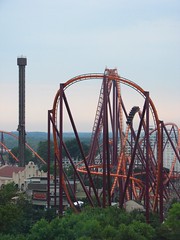
I’m not sure which of Great America’s B&M Quartet is my personal favorite but I think Raging Bull is easily their most ambitious. Unfortunately, that infers that it also must be the one with the most holding it back from the greatness it could be. In this case, quite literally “holding it back”. Two words:
Trim.
Brake.
Ah, I’m foreshadowing too much. First, what is there to like about Raging Bull? Plenty. For starters (and this may be an unpopular opinion) but I personally feel that, at least theoretically, Raging Bull has one of the best layouts ever seen on a B&M speed coaster, perhaps tied only with Apollo’s Chariot. I see a lot more of the attention to layout detailing found on their older rides than all the post-Nitro stuff where it was just about building the same damn camelbacks and turns over and over again.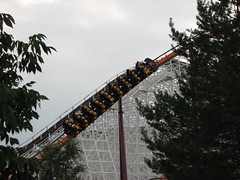 It seems ever since Magnum started the trend, every hyper coaster built has to be entirely airtime based, and built around some variation of an out-and-back layout (if not directly in the plotting, then at least in the spirit of having the hills being the showcase elements with turns randomly inserted as completely disparate elements from the hills). True hyper-twisters are extremely hard to come by; Kings Dominion’s Intimidator 305 may be the closest yet to that ideal, and the Giovanola hypers are probably the next closest thing (in the U.S., at least). Raging Bull was clearly the inspiration for those two, but blends more of the traditional airtime/straight maneuvers with a twistery layout, and in my opinion if it would just run like it’s supposed to it would strike a perfect balance between the two. It seems ever since Magnum started the trend, every hyper coaster built has to be entirely airtime based, and built around some variation of an out-and-back layout (if not directly in the plotting, then at least in the spirit of having the hills being the showcase elements with turns randomly inserted as completely disparate elements from the hills). True hyper-twisters are extremely hard to come by; Kings Dominion’s Intimidator 305 may be the closest yet to that ideal, and the Giovanola hypers are probably the next closest thing (in the U.S., at least). Raging Bull was clearly the inspiration for those two, but blends more of the traditional airtime/straight maneuvers with a twistery layout, and in my opinion if it would just run like it’s supposed to it would strike a perfect balance between the two.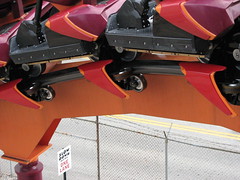
Like every other B&M speed coaster, the seating and restraints are the most comfortable and unrestrictive ever devised for a modern steel coaster, the tipped back seats lifting feet off the floor helping to establish a tremendous sensation of freedom while on the ride. The station also beats other similar rides with similar themes (*cough*kingsisland*cough*), actually recalling a southwestern mission church rather than simply being 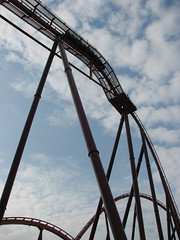 one of the contractor’s prefab steel sheds with wooden paneling nailed in at crooked angles. And from off-ride, Raging Bull actually does some justice to surrounding area; an intimidating presence in the park, to be sure, but it doesn’t dominate the midways and distract attention from the other rides and themed locales. It’s there just a few feet off to the side, impossibly tall and larger than life (probably helped by the fact that you can’t see the footers) but quiet enough that the full impact of its presence doesn’t hit you unless you look it straight in the eyes. The orange track with magenta supports and jet black trains are an original paint combination, not gaudy like the trademark Cedar Fair bright red/yellow, but still attention grabbing, highlighting both the Southwestern inspiration and the technological sheen at the same time. The three, 36 passenger trains cycle through the station with considerable speed, making Raging Bull perhaps the only coaster truly suitable to handle the Great American sized crowds. one of the contractor’s prefab steel sheds with wooden paneling nailed in at crooked angles. And from off-ride, Raging Bull actually does some justice to surrounding area; an intimidating presence in the park, to be sure, but it doesn’t dominate the midways and distract attention from the other rides and themed locales. It’s there just a few feet off to the side, impossibly tall and larger than life (probably helped by the fact that you can’t see the footers) but quiet enough that the full impact of its presence doesn’t hit you unless you look it straight in the eyes. The orange track with magenta supports and jet black trains are an original paint combination, not gaudy like the trademark Cedar Fair bright red/yellow, but still attention grabbing, highlighting both the Southwestern inspiration and the technological sheen at the same time. The three, 36 passenger trains cycle through the station with considerable speed, making Raging Bull perhaps the only coaster truly suitable to handle the Great American sized crowds.
 The first drop is probably my favorite on any B&M speed coaster. The pre-drop section gives a moment to savor the heights and the slight increase in speed off the lift gives the ride a moment to ‘get into gear’ before flooring it with the first drop, if you understand what I’m saying. Then there’s the crest into the 208 ft. drop itself, because of the faster speed from the pre-drop and the fact it has a sharper pull over due to the absence of the lift mechanisms really jolts one out of their seat if they’re sitting in the back, and the front’s not bad either. This isn’t a quick moment of sharp ejector air either, it’s sustained as mild-ejector for the couple seconds it takes to reach the pullout at the bottom, something very few first drops are able to accomplish. Then there’s the underground tunnel at the bottom, which is rare for a B&M (especially their speed coasters) and really helps highlight the sense of speed at the bottom, which can sometimes be a hard thing to judge when the trains run so smoothly. I could probably rate this first drop as one of my top ten favorites. Unfortunately this is probably the best the ride ever has going for it, so enjoy this element while it lasts. The first drop is probably my favorite on any B&M speed coaster. The pre-drop section gives a moment to savor the heights and the slight increase in speed off the lift gives the ride a moment to ‘get into gear’ before flooring it with the first drop, if you understand what I’m saying. Then there’s the crest into the 208 ft. drop itself, because of the faster speed from the pre-drop and the fact it has a sharper pull over due to the absence of the lift mechanisms really jolts one out of their seat if they’re sitting in the back, and the front’s not bad either. This isn’t a quick moment of sharp ejector air either, it’s sustained as mild-ejector for the couple seconds it takes to reach the pullout at the bottom, something very few first drops are able to accomplish. Then there’s the underground tunnel at the bottom, which is rare for a B&M (especially their speed coasters) and really helps highlight the sense of speed at the bottom, which can sometimes be a hard thing to judge when the trains run so smoothly. I could probably rate this first drop as one of my top ten favorites. Unfortunately this is probably the best the ride ever has going for it, so enjoy this element while it lasts.
 Actually the next turn is a nice maneuver as well. Some people dislike it because it’s rather drawn out and not particularly overbanked like the hammerhead maneuvers on Nitro or Diamondback, but I like the shaping to it, how it’s made of three parts, the twisting crest into, the flat turn at top that pushes the positives a bit, then free-falling back down with another rotational twist out of the curve. It all gives a better sense of space and changing directionality than those other turnarounds, even if it is rather slow paced and not particularly aggressive. Actually the next turn is a nice maneuver as well. Some people dislike it because it’s rather drawn out and not particularly overbanked like the hammerhead maneuvers on Nitro or Diamondback, but I like the shaping to it, how it’s made of three parts, the twisting crest into, the flat turn at top that pushes the positives a bit, then free-falling back down with another rotational twist out of the curve. It all gives a better sense of space and changing directionality than those other turnarounds, even if it is rather slow paced and not particularly aggressive.
We surge back up, crossing over the first drop into what should be the ride’s really big airtime centerpiece moment. Instead, we are unexpectedly thrown forward  into our restraints as those nefarious trim brakes clobber our train’s forward momentum. We spend the rest of the hill sitting firmly in our seats, trying to pretend the 0.5 g-forces felt from the descending acceleration on the way down is actual 0-g airtime. It gets worse from here. The next hill, a steeply banked camelback hill, has the potential to be quite awesome, perhaps one of the most daring moments on a B&M speed coaster. There’s not too much inward curvature so in theory it could sustain close to 0 g’s like a regular camelback, only we’d be tipped completely on our sides, creating a rather bizarre disjuncture between sight (extreme) and sensation (relaxed). However, because we’re going so much slower than the design intended, I found myself in a very uncomfortable into our restraints as those nefarious trim brakes clobber our train’s forward momentum. We spend the rest of the hill sitting firmly in our seats, trying to pretend the 0.5 g-forces felt from the descending acceleration on the way down is actual 0-g airtime. It gets worse from here. The next hill, a steeply banked camelback hill, has the potential to be quite awesome, perhaps one of the most daring moments on a B&M speed coaster. There’s not too much inward curvature so in theory it could sustain close to 0 g’s like a regular camelback, only we’d be tipped completely on our sides, creating a rather bizarre disjuncture between sight (extreme) and sensation (relaxed). However, because we’re going so much slower than the design intended, I found myself in a very uncomfortable position as everyone in the train was sliding in their seats down to the left, ironically creating probably the most extreme laterals ever experienced on a B&M speed coaster. position as everyone in the train was sliding in their seats down to the left, ironically creating probably the most extreme laterals ever experienced on a B&M speed coaster.
This is a problem. Why is that trim brake on so hard? The two reasons normally associated for their use (less stress on track/train and controlling the experience for riders) actually have the reverse effects in this case. For riders, both the sudden jolt forward into the seats from the sudden slowdown in speed, and this next hill which puts stress on an awkward position on the left side of the waist from the way the seats are designed. And as far as maintenance is concerned, I can only imagine the frictional wear down on the braking and undercarriage components costs them something over time. Plus I read recently that the train vallied in the figure-eight during a test run on a rather cool day, and fishing out a vallied train, especially a heavy one like Raging Bull’s, I can’t imagine is anything the maintenance department enjoys having called in.
Anyway, so next we pull back up into the other bookending turnaround, this one similar to the first but tighter and crossing over itself on the way out. Some people might complain that the layout wastes too much on these unnecessary turning maneuvers (I recall I had a similar complaint for Diamondback) but in the context of the ride I appreciate that these multiple changes in direction keep the layout feeling longer and more involved than if it were kept much simpler. I think of Raging Bull as having an actual layout, rather than a plot of land that a couple camelback hills can be fit on before they have to turn around after just one or two.
We climb up into the midcourse brake, which mercifully was very light, letting this final section of the ride still have a bit of a pulse. Airtime for those of you in the back (the back is easily the best place to ride on this coaster if you haven’t guessed already) off the midcourse dive, and then again on the subsequent bunny hop. We make our way around a partial uphill helix, appearing for a moment to run out of momentum, but then are met with a dive all the way down to ground level that causes the speedometer to kick up again. off the midcourse dive, and then again on the subsequent bunny hop. We make our way around a partial uphill helix, appearing for a moment to run out of momentum, but then are met with a dive all the way down to ground level that causes the speedometer to kick up again.
Again, some people don’t like this last part but I do. Raging Bull ends with a figure-eight finale, mixed with a few slight rises and minor drops, but for the most part the pace is kept more consistently fast here, always charging into each turn unlike the contrasting dynamics between fast and stalling out that normally come with the bunny hill string as a finale. And this is actually something of a finale. The other speed coasters just end with more of the same, maybe some individual drop or bunny hill that feels a bit more definitive than the rest, but here with the continuous pacing that also contrasts with the rest of the ride experience I actually get something out of this finale, even if it’s not airtime or other sorts of g-forces. I do wish they could have been a bit more daring with some of the transitions here, however, perhaps to be made more like Mantis’ extremely tight figure-eight finale. Regardless it’s a unique close to a unique hyper coaster. with the rest of the ride experience I actually get something out of this finale, even if it’s not airtime or other sorts of g-forces. I do wish they could have been a bit more daring with some of the transitions here, however, perhaps to be made more like Mantis’ extremely tight figure-eight finale. Regardless it’s a unique close to a unique hyper coaster.
I sincerely believe that if they would just turn off the trim brakes and let the damn thing actually carry some g-forces (at least that aren’t unintentional), Raging Bull could be one of B&M’s best efforts. As it rides right now, however, I’m just too… frustrated… whenever I ride it, always keenly aware of how slow every element is taken and how the ride at nearly any given moment could and should be better than it is. Maybe they’re just a seasonal thing and people out there still on a regular basis get trimless rides that show the potential this ride really has. That’s the only reason I can think of for this ride’s #14 placement in the most recent Golden Ticket Awards, outranking even rides like Maverick (well, besides the fact that a cumulative point system will alway show bias towards more well known coasters at popular parks).
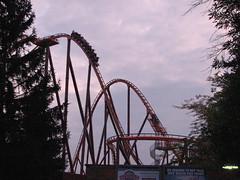 Between the four of these rides, I honestly would have a hard time choosing a favorite after this visit. I could make a case for each Raging Bull, Iron Wolf and Batman… sorry to any Superman fans, but that one’s very close behind the other three. None of them strike me as being clearly ‘great’ coasters, although like I said Raging Bull clearly has the largest potential. Iron Wolf and Batman are relatively more successful, but while each makes the most with what they’re given, neither was given all too much, both being prototype models from early in B&M’s career. In fact I don’t think I could declare any of these to be the best ride in the park. To find out which ride I would bestow that honor to, please read the Classic Steel & Wood review below… the result is almost guaranteed to surprise you. Between the four of these rides, I honestly would have a hard time choosing a favorite after this visit. I could make a case for each Raging Bull, Iron Wolf and Batman… sorry to any Superman fans, but that one’s very close behind the other three. None of them strike me as being clearly ‘great’ coasters, although like I said Raging Bull clearly has the largest potential. Iron Wolf and Batman are relatively more successful, but while each makes the most with what they’re given, neither was given all too much, both being prototype models from early in B&M’s career. In fact I don’t think I could declare any of these to be the best ride in the park. To find out which ride I would bestow that honor to, please read the Classic Steel & Wood review below… the result is almost guaranteed to surprise you.
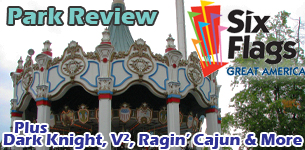 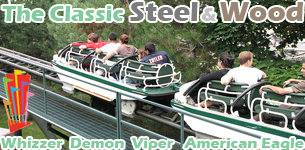
Jackson, New Jersey – Monday, June 9th, 2008
I hadn’t pre-booked any of the hotels before leaving on the trip because in all my traveling experience the only hotel booking website I’ve found to offer any real deals and not just those imaginary ‘promotionals’ is Hotwire. For those of you that have never used Hotwire for your coaster trips, it’s definitely worth at least checking out, since the way their deals work is you buy your room only a day or two before the actual date, and they don’t tell you the exact name and location (but give you enough information that you could easily guess which it is if you compare on other website), the purpose of this all being that you fill rooms that otherwise would have gone empty at extremely reduced prices (doesn’t work if you know the name of the hotel… hello supply-side economics!). Case in point, the night before at Dorney Park we got a very spacious, high-quality hotel in Allentown for I think around $45. It was quite the deal, the hotel had about everything I’d expect from a hotel (which isn’t much, mind you; my idea of ‘traveling cheap’ if I’m by myself would be a couple hours in a commuter lot with a blanket and pillow in a car), the only thing it didn’t have was wireless internet connection in the rooms, and of course I forgot to bring my ethernet connection.
 I mention all this in my SFGAdv review because the night before I was only able to get a weak connection in the hotel lobby, and all my searches for hotels near the Great Adventure area turned up in vain, though I figured it was because of the poor connection was causing things to time-out since the pages were rarely loading properly anyway. So we decided it would probably be better to just drive the way to Six Flags Great Adventure for our two days of stay there and find a decent looking hotel ourselves for that night. So as soon as we enter NJ we start looking for exits with some decent hotels. There’s one, but I think we’re still too far away and we should try to get a bit closer. So we keep on driving, and driving… and driving. Nothing. No hotels anywhere along I-95/195 at all. Not even the most run-down looking roadside motel that would look as if it belongs in a Hitchcock thriller. We finally get to, and then pass Great Adventure, and keep on driving, looking for some hotel anywhere, and finally decide to turn around when we realize we’re already approaching the ocean. We stopped at a gas station and asked the attendant if he knew where the hotels that people going to SFGAdv stayed at were, and he had almost no clue where one might stay that didn’t involve crossing state lines. After passing back and forth the area a few times, taking various side roads in the hope that they might lead to somewhere, I think we finally found a hotel, nothing particularly nice and prices closer to $90, and were finally able to call it a night. I mention all this in my SFGAdv review because the night before I was only able to get a weak connection in the hotel lobby, and all my searches for hotels near the Great Adventure area turned up in vain, though I figured it was because of the poor connection was causing things to time-out since the pages were rarely loading properly anyway. So we decided it would probably be better to just drive the way to Six Flags Great Adventure for our two days of stay there and find a decent looking hotel ourselves for that night. So as soon as we enter NJ we start looking for exits with some decent hotels. There’s one, but I think we’re still too far away and we should try to get a bit closer. So we keep on driving, and driving… and driving. Nothing. No hotels anywhere along I-95/195 at all. Not even the most run-down looking roadside motel that would look as if it belongs in a Hitchcock thriller. We finally get to, and then pass Great Adventure, and keep on driving, looking for some hotel anywhere, and finally decide to turn around when we realize we’re already approaching the ocean. We stopped at a gas station and asked the attendant if he knew where the hotels that people going to SFGAdv stayed at were, and he had almost no clue where one might stay that didn’t involve crossing state lines. After passing back and forth the area a few times, taking various side roads in the hope that they might lead to somewhere, I think we finally found a hotel, nothing particularly nice and prices closer to $90, and were finally able to call it a night.
We left the next morning for Great Adventure as late as possible to still be ‘early’. So we make our way to the entrance only to find that the road is packed. About a fifteen minute wait in a sea of traffic to get our parking tickets, then another good twenty minute wait at the main gate to get my season pass, and it’s very apparent that today is going to packed. I get to the window and ask if the season pass still has the Bring-a-Friend for free on weekdays through June. She replies that she’s pretty sure they’ve stopped doing that. Huh? Have they stopped offering that on newly sold season passes or have they cut perks from all passes? Either way didn’t make a whole lot of sense, but with that information in mind I realized it would now be cheaper to each buy an individual ticket with a promotion I found in a brochure in the hotel the night before and happened to think to bring along, just in case. So we finally get into the park, and the midways are pretty well choked, although I suppose it could have been worse. Still, for an early June Monday, when just the weekend before all our parks were visited with considerably small crowds, this was not what I was expecting.
 So we make our way to the first ride of the day, I figure Batman: The Ride is a good one to start off with. The queue is indoors at least, which I figure given the rising heat that morning would at least offer that escape, if only the queue were air-conditioned (or ventilated…), that is. I never really think of myself as liking Batman the Ride, but then just before visiting a park that has one I remember the tighter, more intense layout and figure that I actually like this design much more than I remember. But then I always get to the ride, which so far has invariably been at an over-crowded Six Flags park on a miserably hot day and the whole thing becomes and ordeal for a just one ride that’s too short and then when all said and done I’m still no closer to figuring out if I like this design in relation to other B&M inverts or not. Maybe some other year I’ll finally be able to figure that one out, but all I can say is my light fantasy leading up to that visit of hitting Batman first, getting a bunch of re-rides before the (minor) crowds hit was not going to come true. While in the queue and trying to assess the somewhat grim looking situation I figure that it might be worth it on the second day to get a Fast-Pass. So we make our way to the first ride of the day, I figure Batman: The Ride is a good one to start off with. The queue is indoors at least, which I figure given the rising heat that morning would at least offer that escape, if only the queue were air-conditioned (or ventilated…), that is. I never really think of myself as liking Batman the Ride, but then just before visiting a park that has one I remember the tighter, more intense layout and figure that I actually like this design much more than I remember. But then I always get to the ride, which so far has invariably been at an over-crowded Six Flags park on a miserably hot day and the whole thing becomes and ordeal for a just one ride that’s too short and then when all said and done I’m still no closer to figuring out if I like this design in relation to other B&M inverts or not. Maybe some other year I’ll finally be able to figure that one out, but all I can say is my light fantasy leading up to that visit of hitting Batman first, getting a bunch of re-rides before the (minor) crowds hit was not going to come true. While in the queue and trying to assess the somewhat grim looking situation I figure that it might be worth it on the second day to get a Fast-Pass.
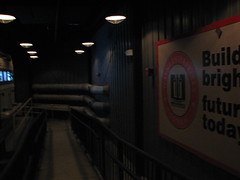 After Batman it seemed appropriate to get the other, newer Batman next door out of the way. The wait for the Dark Knight was I think around forty-five minutes total, at least twenty of those spent outdoors with all the televisions blasting out non-stop promotions and others sorts of Six Flags attitude. I suppose Six Flags execs are patting each other on the back for being so cutting edge in commercial synergies and in-park media, and I hope they keep it to themselves because the day my local Cedar Fair parks start pumping advertisements and other self-promotional into their queue lines is the day a season pass will no longer be necessary for me. It used to be that you could spend the time in line enjoying a nice conversation, people watch, or watch the ride you’re about to try in quiet awe, but Six Flags has figured out that when you put television screens in front of people with nothing better to do, they’ll be drawn to them like a bug to a zapper, no matter how awful their programming is. Here everyone just paid attention to the TV screens, the perfect little consumers we all are whenever there’s a LCD screen around, and most would make sarcastic quips to their friends every time the “More Flags More Fun” commercial came on that this right now qualified for one flag although by the end of the line we’d heard that joke enough that it just became dispiriting how artificial it all was, I’d swear this ride is far better themed to Soylent Green or some other dystopian-consumerism film than The Dark Knight [mmm… maybe Dawn of the Dead? I’d love an amusement area themed to that]. After Batman it seemed appropriate to get the other, newer Batman next door out of the way. The wait for the Dark Knight was I think around forty-five minutes total, at least twenty of those spent outdoors with all the televisions blasting out non-stop promotions and others sorts of Six Flags attitude. I suppose Six Flags execs are patting each other on the back for being so cutting edge in commercial synergies and in-park media, and I hope they keep it to themselves because the day my local Cedar Fair parks start pumping advertisements and other self-promotional into their queue lines is the day a season pass will no longer be necessary for me. It used to be that you could spend the time in line enjoying a nice conversation, people watch, or watch the ride you’re about to try in quiet awe, but Six Flags has figured out that when you put television screens in front of people with nothing better to do, they’ll be drawn to them like a bug to a zapper, no matter how awful their programming is. Here everyone just paid attention to the TV screens, the perfect little consumers we all are whenever there’s a LCD screen around, and most would make sarcastic quips to their friends every time the “More Flags More Fun” commercial came on that this right now qualified for one flag although by the end of the line we’d heard that joke enough that it just became dispiriting how artificial it all was, I’d swear this ride is far better themed to Soylent Green or some other dystopian-consumerism film than The Dark Knight [mmm… maybe Dawn of the Dead? I’d love an amusement area themed to that].
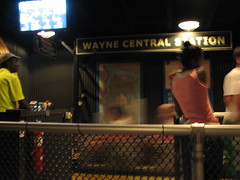 Anyway thankfully we were the very last ones to be let into the air-conditioned anti-chambers, which as it happens is the best part of the ride. For the most part it seemed that the ride’s creative designers missed a memo from Warner Brothers that Tim Burton and Joel Schumaker were no longer directing the franchise since that still seemed to be where they wanted to pull a lot of the scenery elements from for most of the attraction, although at least they managed to get Aaron Eckhart to do some contractually obligated work for an intro video. I even partly admire the intro scene since it a bit more ambiguous and requires more close attention to figure out exactly what the set-up is, but given the average SFGAdv patron the competing noise level in the room made it impossible to decipher any of the back story. Then we were let into the next chamber which we got to spend at least another twenty minutes in, the best feature of which is that it’s air conditioned. They’ve even got some pretty decent themeing throughout so that by the time you get in the ride vehicle you think you could be in for something fairly decent. Anyway thankfully we were the very last ones to be let into the air-conditioned anti-chambers, which as it happens is the best part of the ride. For the most part it seemed that the ride’s creative designers missed a memo from Warner Brothers that Tim Burton and Joel Schumaker were no longer directing the franchise since that still seemed to be where they wanted to pull a lot of the scenery elements from for most of the attraction, although at least they managed to get Aaron Eckhart to do some contractually obligated work for an intro video. I even partly admire the intro scene since it a bit more ambiguous and requires more close attention to figure out exactly what the set-up is, but given the average SFGAdv patron the competing noise level in the room made it impossible to decipher any of the back story. Then we were let into the next chamber which we got to spend at least another twenty minutes in, the best feature of which is that it’s air conditioned. They’ve even got some pretty decent themeing throughout so that by the time you get in the ride vehicle you think you could be in for something fairly decent.  Then you take the first turn and are greeted with a wild mouse in a box, effectively killing all the build-up from the pre-show. There are a couple partially enclosed tunnels on the top couple of switchbacks, complete with a strobelight flashing on a Batman figurine in one section, which turned out to be about as technical as they were willing to go for on-ride effects. The rest of the wild mouse takes place without nearly any themeing and plenty of light, although the nice thing was they weren’t braking it at all. On the exit even the pathway takes you right underneath the ride area, with the exit door being inside the main building, letting in large amounts of light into the ride area every time someone opened the door. Especially compared to the wonderful Exterminator this ride just screamed ‘incompetent’ at every level, and overall the whole experience, from the barrage of queue-mmercials to the overwhelmingly cheap ride experience, was just plain embarrassing in its blatantly artless commercialism, even going so far as to detract from the cinematic experience a month later when, for all that films layered interpretations about the dualistic nature of heroism and the like, I’d think back on my experience with the coaster and remember how the film was still just part of the corporate franchise machine. Then you take the first turn and are greeted with a wild mouse in a box, effectively killing all the build-up from the pre-show. There are a couple partially enclosed tunnels on the top couple of switchbacks, complete with a strobelight flashing on a Batman figurine in one section, which turned out to be about as technical as they were willing to go for on-ride effects. The rest of the wild mouse takes place without nearly any themeing and plenty of light, although the nice thing was they weren’t braking it at all. On the exit even the pathway takes you right underneath the ride area, with the exit door being inside the main building, letting in large amounts of light into the ride area every time someone opened the door. Especially compared to the wonderful Exterminator this ride just screamed ‘incompetent’ at every level, and overall the whole experience, from the barrage of queue-mmercials to the overwhelmingly cheap ride experience, was just plain embarrassing in its blatantly artless commercialism, even going so far as to detract from the cinematic experience a month later when, for all that films layered interpretations about the dualistic nature of heroism and the like, I’d think back on my experience with the coaster and remember how the film was still just part of the corporate franchise machine.
 Moving on to Nitro. The line for Nitro wasn’t too bad, still pretty long but at least they got it to move faster than any others for that day. Noticed some people were collapsing from heat exhaustion while in the unshaded line, at least the Six Flags staff were adequately taking care of them. As onlookers watched them get a free bottled water and a ride in a shaded golf cart back to a medical center, I mused if that would all be worth self-inducing a heat stroke. In the end I figured you have to give up your place in line, so probably better off not to. That’s how desperate we all were for some shade. We got a front seat row for the ride itself. Moving on to Nitro. The line for Nitro wasn’t too bad, still pretty long but at least they got it to move faster than any others for that day. Noticed some people were collapsing from heat exhaustion while in the unshaded line, at least the Six Flags staff were adequately taking care of them. As onlookers watched them get a free bottled water and a ride in a shaded golf cart back to a medical center, I mused if that would all be worth self-inducing a heat stroke. In the end I figured you have to give up your place in line, so probably better off not to. That’s how desperate we all were for some shade. We got a front seat row for the ride itself.
I like Nitro better than I want to, which is weird because I don’t like Apollo’s Chariot as much as I want to. If my opinion of each could switch, then I’d be happy. Nitro for some reason I really like even though it’s just large, separate elements plugged in to one another while taking place over the beautiful surrounding New Jersey cesspool, something I normally would critique the hell out of today, but I still came back with my high opinion of it from 2003 virtually unchanged. Meanwhile Apollo’s Chariot (which I rode for the first time the previous year), despite actually having terrain, unique shaping, strategically placed flat sections to give it some actual pacing and character (on a B&M? Unheard of!), 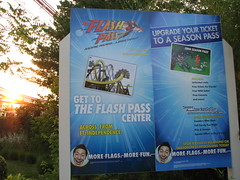 in fact from off-ride I’d say AC is B&M’s best designed ride in my eyes, yet I didn’t like it when I actually got the chance to ride it. I figure it must be that Nitro has the extra speed and height to make the whole speed coaster concept work for me, but still I just can’t figure out my own opinions on this ride. It would help if I could ever ride any Six Flags coaster more than just once a visit, though. in fact from off-ride I’d say AC is B&M’s best designed ride in my eyes, yet I didn’t like it when I actually got the chance to ride it. I figure it must be that Nitro has the extra speed and height to make the whole speed coaster concept work for me, but still I just can’t figure out my own opinions on this ride. It would help if I could ever ride any Six Flags coaster more than just once a visit, though.
After Nitro we tried getting a free complementary ice water after waiting in line for about eight minutes at a small food corral. If it wasn’t already obvious my opinion of Six Flags up to this point was not very high and it wouldn’t have surprised me to be turned down. But thankfully, no, they did in fact offer complementary ice water, in a Dixie cup size somewhere between “Shot Glass” and “Baby’s First Tippy Cup”.
We wandered along the wooded backside of the park which was not crowded at all (I guess because there’s nothing back there), and got in a quick ride on Blackbeard’s Lost Treasure Train, which had no line, mostly to boost our Rides-per-Hour ratio somewhat. This is partly what surprises me about Great Adventure, there actually is some decent terrain and lakefront property here that they could work with, but instead any nice views or anything are all closed off by a thin layer of trees and other buildings, leaving the main scenic views of the outside world from major attractions to be only the parking lot from Ka/Superman, or the waste containment area (whatever it is) next to Nitro. If they could just cut the tree layers back and utilize that large lake system they have behind the park it might actually feel kind of nice, but instead the entire infrastructure is entirely inward facing on large concrete midways clogged with tastelessly styled rides and building (the eastern part of the park has thankfully improved over the past few years). which had no line, mostly to boost our Rides-per-Hour ratio somewhat. This is partly what surprises me about Great Adventure, there actually is some decent terrain and lakefront property here that they could work with, but instead any nice views or anything are all closed off by a thin layer of trees and other buildings, leaving the main scenic views of the outside world from major attractions to be only the parking lot from Ka/Superman, or the waste containment area (whatever it is) next to Nitro. If they could just cut the tree layers back and utilize that large lake system they have behind the park it might actually feel kind of nice, but instead the entire infrastructure is entirely inward facing on large concrete midways clogged with tastelessly styled rides and building (the eastern part of the park has thankfully improved over the past few years).
That rides-per-hour ratio I just mentioned was going to quickly plummet after this. From there we moved over to do Great American Scream Machine, one of the rides I skipped back in 2003 on the premise that it should be dismissed because it’s ‘too rough’ (unfortunately Viper was also overlooked then for the same reason). However the heat was playing with the lift engine causing the ride to be down when we got over there. Superman had far too long of a wait, so we did the Parachute Tower which didn’t have much of a line, although the fact that they were only running two of the parachutes didn’t necessarily mean the wait was short. I am still glad I did this one because A): it’s a classic, and B): 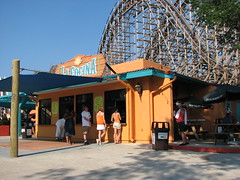 I got to savor the views of El Toro for the first time from up there, and marveled at how ridiculous that first drop looked in real life. While up there, I also couldn’t help but suppress the suspicion that ET was not currently in operation. When we got over there to check it out, those suspicions were confirmed. “It’s down because of the heat” seemed to be the reason why. From there looked at the wait for the Mine Train (too long), the Log Flume (down), Medusa (too long), Rolling Thunder (left side, the side I hadn’t been on, closed, right side, too long). That left us with the only intermittently down Kingda Ka, or… um. Well I wanted to save Ka for Day 2, have something new to try for then, especially if we’re getting a Fast Pass. In the end we decided to just camp out by El Toro’s entrance since it looked like they had some people working on it and I think a test train was even sent out, while I frequented La Cocina filling up on ice waters. I got to savor the views of El Toro for the first time from up there, and marveled at how ridiculous that first drop looked in real life. While up there, I also couldn’t help but suppress the suspicion that ET was not currently in operation. When we got over there to check it out, those suspicions were confirmed. “It’s down because of the heat” seemed to be the reason why. From there looked at the wait for the Mine Train (too long), the Log Flume (down), Medusa (too long), Rolling Thunder (left side, the side I hadn’t been on, closed, right side, too long). That left us with the only intermittently down Kingda Ka, or… um. Well I wanted to save Ka for Day 2, have something new to try for then, especially if we’re getting a Fast Pass. In the end we decided to just camp out by El Toro’s entrance since it looked like they had some people working on it and I think a test train was even sent out, while I frequented La Cocina filling up on ice waters.
It sure takes a lot of work to have fun at Six Flags.
Good news. A small line started forming around El Toro‘s entrance, and workers looked like they were about ready to send someone down to open it up. We quickly made it in, and the line opened. We made our way to the back of the train, and were able to be the second people in for the very back row. Now even though we were only one train away from riding it still took a good fifteen minutes to actually ride. The test train they sent out just before letting the first load of people on before us became stopped at the top of the lift hill. Not that it was viewable from the station, but my suspicions were aroused when it went up but never came down. The trainees running things never noticed as they took their  sweet time to make sure their first trainload was loaded properly, until it came time to dispatch when it was obvious that the first block had never cleared. Well, they sent someone up there, came back down, they finally got it working, and dispatched the first train. We were loaded in, had to check restraints twice (fine by me since my lapbar came down a bit too tight the first time), and finally we were off. First ride on El Toro was definitely something, although I’ll admit, maybe it was just being tired from the heat and waiting and everything, but when I actually got to my first experience with El Toro, rather than have a heightened sense of reality as is normal with the first ride on a record-breaking coaster like this, I felt curiously removed from the whole experience, especially from the first series of camelback hills. sweet time to make sure their first trainload was loaded properly, until it came time to dispatch when it was obvious that the first block had never cleared. Well, they sent someone up there, came back down, they finally got it working, and dispatched the first train. We were loaded in, had to check restraints twice (fine by me since my lapbar came down a bit too tight the first time), and finally we were off. First ride on El Toro was definitely something, although I’ll admit, maybe it was just being tired from the heat and waiting and everything, but when I actually got to my first experience with El Toro, rather than have a heightened sense of reality as is normal with the first ride on a record-breaking coaster like this, I felt curiously removed from the whole experience, especially from the first series of camelback hills.
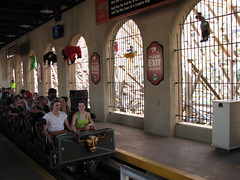 Regardless by the time we got to the brakes (and I had plenty of time to reflect there as well as we waited for the next train to clear the station) I realized just how different this was from any other wooden coaster I had tried before. I wasn’t ready to commit to say ‘better’, but most definitely different. (Random note, but for some reason the exit path requires you to make a bee-line through a series of tables if you want to get back to the ride entrance, which is where we were clearly headed after that first ride). The line was mercifully still very short, given it’s such a high-profile attraction I figured everyone in the park would be there upon news of its reopening but the line was only to the middle of the stairs that lead directly into the loading platform. Second time around we decided to wait for the front row. I counted about fifteen groups ahead of us for the wait, not too bad considering that was all the line would entail. Regardless by the time we got to the brakes (and I had plenty of time to reflect there as well as we waited for the next train to clear the station) I realized just how different this was from any other wooden coaster I had tried before. I wasn’t ready to commit to say ‘better’, but most definitely different. (Random note, but for some reason the exit path requires you to make a bee-line through a series of tables if you want to get back to the ride entrance, which is where we were clearly headed after that first ride). The line was mercifully still very short, given it’s such a high-profile attraction I figured everyone in the park would be there upon news of its reopening but the line was only to the middle of the stairs that lead directly into the loading platform. Second time around we decided to wait for the front row. I counted about fifteen groups ahead of us for the wait, not too bad considering that was all the line would entail. Still the wait took close to 50 minutes, thanks to said trainees taking forever (I was mildly irked that the ‘supervisor’-type personalities standing watch over the trainees at the control panel didn’t expedite things and help the restraint checkers speed things up). It occurred to my dad what probably was the result of all these large crowds and trainees present everywhere were, it was most likely the first weekday of summer vacation for all the New Jersey schools, thus leading it to be the case for every youth in the state that if they weren’t already starting work at Great Adventure today, there were going to be there to ride coasters anyway. If there was one silver lining to having trainees check restraints, it’s that the girl on the right side of the train was still very cautious not to invade anyone’s personal space which meant an extremely comfortable lapbar position on my second go-round. Still the wait took close to 50 minutes, thanks to said trainees taking forever (I was mildly irked that the ‘supervisor’-type personalities standing watch over the trainees at the control panel didn’t expedite things and help the restraint checkers speed things up). It occurred to my dad what probably was the result of all these large crowds and trainees present everywhere were, it was most likely the first weekday of summer vacation for all the New Jersey schools, thus leading it to be the case for every youth in the state that if they weren’t already starting work at Great Adventure today, there were going to be there to ride coasters anyway. If there was one silver lining to having trainees check restraints, it’s that the girl on the right side of the train was still very cautious not to invade anyone’s personal space which meant an extremely comfortable lapbar position on my second go-round.
 Second ride: This time I was much more into it. While everyone else seems to be talking about the back seat on this ride being the place to be, I found the front seat to be the superior placement. Only real advantage the back had was the extra strong ejector on the first drop, but compared to Maverick’s ultra-tight, 95 degree drop in the back seat, El Toro could only close to comparison, far from exceeding. The front, however, was a far more visceral experience on the first half of the ride, having no obstructions and with the first series of hills setting a powerful if not slightly 1-note opener. The first turnaround I didn’t care for as much as I hoped, after the first few hills it was clear the ride was going to use all its speed and smoothness to focus on raw power rather than a more colorfully characterized, uniquely profiled experience, and the first turn-around seemed to be lacking that power as well as it just flew through the element Second ride: This time I was much more into it. While everyone else seems to be talking about the back seat on this ride being the place to be, I found the front seat to be the superior placement. Only real advantage the back had was the extra strong ejector on the first drop, but compared to Maverick’s ultra-tight, 95 degree drop in the back seat, El Toro could only close to comparison, far from exceeding. The front, however, was a far more visceral experience on the first half of the ride, having no obstructions and with the first series of hills setting a powerful if not slightly 1-note opener. The first turnaround I didn’t care for as much as I hoped, after the first few hills it was clear the ride was going to use all its speed and smoothness to focus on raw power rather than a more colorfully characterized, uniquely profiled experience, and the first turn-around seemed to be lacking that power as well as it just flew through the element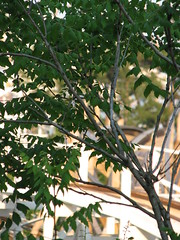 with an impressive if not slightly languid gracefulness in it’s high banked turns. with an impressive if not slightly languid gracefulness in it’s high banked turns.
Now here’s where El Toro really started to work for me. The shallow hill on the return run, while without the strong airtime present in the first maneuvers, startled me when I realized that for what almost appeared to be a straight-away there actually was still some noticeable airtime present. Consider also the wind felt in the front seat and the wooden support structure built around it and impression that we were actually gaining speed into the much more tightly plotted second half of the ride was mild cause for alarm and anticipation. The left-hand turn, with it’s moment of sudden headchoppers, is the perfect set-up to the sudden, and incredibly violent change of pace for the twister section of the ride. Everyone that’s been on El Toro I know of has talked about the viciousness of the Rolling Thunder hill. It’s far more intense than the previous hills in every possible way, in both psychological lead-up, fleetness in the transitions and relative rotation change, and, of course, the raw intensity of the ‘uplift’ itself.
The tightened pacing for the second half does not let a millisecond go wasted as it’s into a series of tight switchbacks at ground level, an awesome experience partly just because it’s so contrary to the entire first half of the ride. I was a bit worried that the return series of hilly curves would be taken too slowly as I had seen in all the videos, but the extreme heat meant the wheels were running fast and I was quite surprised when these final hills also offered some strong spurts of air, mixed in with the ‘dancing’ of the train from right to left.
Overall I was a bit worried El Toro, with it’s plug-and-play technology and train design, might have been a bit over-hyped by the masses that would prefer the most straight-forward Intamin Hyper coaster over any authentic wooden coaster any day. Thankfully El Toro works well on both levels, and while I can’t even call it the best wooden coaster from 2006 (that distinction belongs to the Voyage) I was pleased to find at the end of the trip that I was still able to place it firmly in my top ten list, just above Hades (similar size and pacing structures, although Hades is interesting in that it’s progression is actually the opposite of ET, although Hades’ amazing tunnels just barely got edged out by ET’s raw power).
After this ride the sky was starting to turn a dusty red/purple, indicating the sun was heading west and we only had about an hour until the park’s 7:00 close. While heading over to the now opened Great American Scream Machine I got a call from my mom wanting to know how things were going. While the rides here were great, I had to be honest that being back on the hot, crowded midways was miserable (thankfully though the crowds were starting to thin and it wasn’t quite as hot as that afternoon). It seemed like all that I really had left that I really wanted to accomplish while at Great Adventure was get a ride in on both GASM and Kingda Ka, and if the wait for GASM was short enough that seemed entirely do-able for the day. As it happened, GASM was walk-on.
 Great American Scream Machine was of particular interest to my dad, since his first experience with a large-scale, intense coaster was when he was director of a school marching band, taking his band to play at Six Flags Great America back in 1990, and rode the Shockwave while there. Of course now we go on much bigger and more intense all the time, but, with that original Shockwave gone, he was finally able to compare that original experience 18 years ago with today. We got the second-to back row, generally a preferred seat for the Arrow multi-loopers. The ride itself was perfectly smooth and tolerable, the design is odd because of how quickly it seems to shrink throughout the ride experience. Tremendous first drop and loop, the next two loops are still very fast but feel a bit smaller scale due to the elevation. The midcourse practically bringing it to a halt, the twist down into the batwing has some neat dynamics, and by the time it gets to the final corkscrew and turn the scale of things has pretty much been reduced to remind me of Michigan’s Adventure’s model. Still they don’t quite make multi-loopers like this anymore, and I still managed to come off the ride thoroughly impressed by what is normally an overlooked coaster. Great American Scream Machine was of particular interest to my dad, since his first experience with a large-scale, intense coaster was when he was director of a school marching band, taking his band to play at Six Flags Great America back in 1990, and rode the Shockwave while there. Of course now we go on much bigger and more intense all the time, but, with that original Shockwave gone, he was finally able to compare that original experience 18 years ago with today. We got the second-to back row, generally a preferred seat for the Arrow multi-loopers. The ride itself was perfectly smooth and tolerable, the design is odd because of how quickly it seems to shrink throughout the ride experience. Tremendous first drop and loop, the next two loops are still very fast but feel a bit smaller scale due to the elevation. The midcourse practically bringing it to a halt, the twist down into the batwing has some neat dynamics, and by the time it gets to the final corkscrew and turn the scale of things has pretty much been reduced to remind me of Michigan’s Adventure’s model. Still they don’t quite make multi-loopers like this anymore, and I still managed to come off the ride thoroughly impressed by what is normally an overlooked coaster.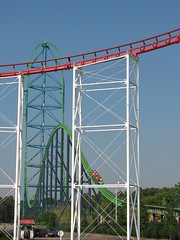
Last ride of the day: Kingda Ka. Got in line about a half-hour to park’s close. It quickly became apparent that things were very start and go. It would launch a couple trains in fast succession, and then there’d be a 10 minute wait for the next batch to go. A couple times it closed down altogether for at least a half hour. While in line someone recognized my CoasterSims t-shirt, and introduced himself as vandelay.corp. We had a quick conversation about CS and the park before the line started moving again. After about an hour and a half of waiting we got into the station. While I would have liked to have tried the front row there was already quite a line for it and it was obvious they were probably going to have to ask some of the people waiting for it to move to other rows once the maybe 2 or 3 trainloads worth of people behind us were accommodated, so we got the second-to-front row instead. A mechanic/supervisor running the ride from the operator’s booth let us know that the heat was causing the sensors to fail so he was going to have to manually oversee every launch, but they were sure to make sure everyone in line got a ride no matter how long after park closing it was.
Kingda Ka is even more like Top Thrill Dragster than I would have expected. That’s probably a good thing. The anticipation of the launch is about the same, the launch itself is about the same. The tower feels about the same. The only thing Kingda Ka really does that Dragster doesn’t is offer the camelback hill, but even that’s not as notable as I would have guessed. Speed and height feel pretty similar, perhaps a bit more in Ka’s case, and that difference probably would have been even more notable had I gone in the very front. TTD I think is still the superior ride for a few reasons. First, the use of only lapbars on that one does make the experience a whole lot more precarious feeling, although I will admit the OTSRs on Ka were not as intrusive as I thought they would be. Well, they have the same type on Maverick so I shouldn’t have been surprised, although as I recall there was a moment as I was going up and over the tower that there was a moment that I felt like I couldn’t feel any restraints and I had a split-second of panic at thinking they had maybe come undone before I realized they were still there. Also, Six Flags did not utilize the ride’s location very well.  Dragster is right at midway level, and the sensation of speed is increased by having all the midway and rides and everything tearing away in the background, while Ka just sits above an even lining of trees the entire way down, and the parking lot on the other side. But overall it’s still quite the ride experience, and I’m quite glad I managed to get a ride in. Dragster is right at midway level, and the sensation of speed is increased by having all the midway and rides and everything tearing away in the background, while Ka just sits above an even lining of trees the entire way down, and the parking lot on the other side. But overall it’s still quite the ride experience, and I’m quite glad I managed to get a ride in.
 After the ride was over we waited around on the exit platform that overlooks the ride, watching a few other launches go and took some pictures, while discussing what we wanted to do the next day. As great as the rides were, that unfortunately represented only less than 1% of the actual time spent in the park, the rest of which, the heat and crowds just made it miserable. We could have splashed a lot of money down on a Flash Pass, but given I had now done everything I really wanted to get out of my visit (El Toro front and back, Kingda Ka, Dark Knight, Great American Scream Machine, a ride on Nitro to compare to AC from last year… plus a ‘bonus’ ride on Batman and the Parachute tower, wish I had done Medusa instead, though) it seemed that the money and effort put into a second day’s visit would be pointless, especially considering the season pass w/ bring-a-friend deal didn’t work out. Given the number of smaller parks along the Jersey coastline, that seemed a much more pleasant way to spend the day. Back at the hotel, showered, I checked online to find a good alternative. There was Bowcraft park and it’s interesting looking Crossbow, After the ride was over we waited around on the exit platform that overlooks the ride, watching a few other launches go and took some pictures, while discussing what we wanted to do the next day. As great as the rides were, that unfortunately represented only less than 1% of the actual time spent in the park, the rest of which, the heat and crowds just made it miserable. We could have splashed a lot of money down on a Flash Pass, but given I had now done everything I really wanted to get out of my visit (El Toro front and back, Kingda Ka, Dark Knight, Great American Scream Machine, a ride on Nitro to compare to AC from last year… plus a ‘bonus’ ride on Batman and the Parachute tower, wish I had done Medusa instead, though) it seemed that the money and effort put into a second day’s visit would be pointless, especially considering the season pass w/ bring-a-friend deal didn’t work out. Given the number of smaller parks along the Jersey coastline, that seemed a much more pleasant way to spend the day. Back at the hotel, showered, I checked online to find a good alternative. There was Bowcraft park and it’s interesting looking Crossbow, 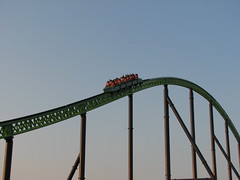 but that was inland, isolated, and farther north than I expected. Expensive too. Morey’s Piers were too far south, plus I had an offer through Amusement Today from them for a free VIP visit to their park to all Golden Tickets Award voters, in an effort to boost up their rankings in certain areas. Since I left that promotion at home I would have felt rather silly not using it now. A much better alternative seemed to be the Casino Pier and Funtown Pier, only 23 miles due east, each with an interesting looking collection of compact steel coasters over the water. Except both were closed on Tuesday. Some other small parks, nothing noteworthy. Finally I found something that would work as an alternative plan. Ocean City. 60-some miles south-east of us. Two competing amusement zones with at least three ‘adult-sized’ coasters between them. A full boardwalk and beach. Sounds great. Let’s do that. but that was inland, isolated, and farther north than I expected. Expensive too. Morey’s Piers were too far south, plus I had an offer through Amusement Today from them for a free VIP visit to their park to all Golden Tickets Award voters, in an effort to boost up their rankings in certain areas. Since I left that promotion at home I would have felt rather silly not using it now. A much better alternative seemed to be the Casino Pier and Funtown Pier, only 23 miles due east, each with an interesting looking collection of compact steel coasters over the water. Except both were closed on Tuesday. Some other small parks, nothing noteworthy. Finally I found something that would work as an alternative plan. Ocean City. 60-some miles south-east of us. Two competing amusement zones with at least three ‘adult-sized’ coasters between them. A full boardwalk and beach. Sounds great. Let’s do that.
Since we had not had anything to eat at the park we went out to get a good meal, and ended up at a Longhorn Steakhouse. The restaurant was pretty quiet in those late hours, and the meal itself was enormous, juicy and delicious, exactly what I needed. The real winner however was an item that caught my attention on the dessert menu: Golden Nugget Fried Cheesecake. Creamy cheesecake lightly breaded, flash-fried to crisp perfection and served over ice cream with strawberry sauce and a raspberry-caramel swirl. Topped with real whipped cream and served in a chilled goblet.
That is how you end a day. 🙂
(P.S.- I appologize for the relative lack of photos for this review since I went through most of the day planning to get my shots the next day, which then never ended up happening)
|
|
 A dialectic runs through my head over whether or not I think Batman is one of B&M’s finest inverted coasters, or simply a scaled-back practice outing that they would later refine and build upon. One part of me (we’ll say it’s my right brain) keeps saying, “Of course it is! This is by far the tightest design they ever made for an inverted coaster, back before they became too dependent on force readouts and still made coasters with some kick to them. Everything else after this design was compromised by taller heights and faster speeds… ergo, more controlled forces and slower timing between elements. It might be small and short, but it’s non-stop and packs the most aggressive punch Bolliger & Mabillard has ever made – or will ever make.”
A dialectic runs through my head over whether or not I think Batman is one of B&M’s finest inverted coasters, or simply a scaled-back practice outing that they would later refine and build upon. One part of me (we’ll say it’s my right brain) keeps saying, “Of course it is! This is by far the tightest design they ever made for an inverted coaster, back before they became too dependent on force readouts and still made coasters with some kick to them. Everything else after this design was compromised by taller heights and faster speeds… ergo, more controlled forces and slower timing between elements. It might be small and short, but it’s non-stop and packs the most aggressive punch Bolliger & Mabillard has ever made – or will ever make.” But then the other half of my brain (the left hemisphere) chimes in, “Don’t get too sentimental. While the design of the elements might be tight, that’s only to be canceled out by the extra-small scale and speed. The ride time is short as well, and while it might not be a bad coaster, there are plenty of other inverts built after it that are much more ambitious. The only reason it’s been duplicated so many times is because it’s small, cheap and easily accessible for lazy parks that don’t feel like taking any risks with their design.”
But then the other half of my brain (the left hemisphere) chimes in, “Don’t get too sentimental. While the design of the elements might be tight, that’s only to be canceled out by the extra-small scale and speed. The ride time is short as well, and while it might not be a bad coaster, there are plenty of other inverts built after it that are much more ambitious. The only reason it’s been duplicated so many times is because it’s small, cheap and easily accessible for lazy parks that don’t feel like taking any risks with their design.” still seems stuck at the phase where I need to ride it more to decide how much I really enjoy it. Not helping is the fact that I can usually only ride it once or twice a year, and the simple struggle it usually is to survive a day in a Six Flags park, with all the long lines and dehydration that normally entails. But if right is right I should have a stronger opinion of the coaster by now, so maybe my left brain is correct and I’m simply transferring my sentimentality for other pre-1998 B&M coasters onto this design. Maybe what I need is a good old fashioned ride analysis written miles away from the nearest working example settle my internal debate.
still seems stuck at the phase where I need to ride it more to decide how much I really enjoy it. Not helping is the fact that I can usually only ride it once or twice a year, and the simple struggle it usually is to survive a day in a Six Flags park, with all the long lines and dehydration that normally entails. But if right is right I should have a stronger opinion of the coaster by now, so maybe my left brain is correct and I’m simply transferring my sentimentality for other pre-1998 B&M coasters onto this design. Maybe what I need is a good old fashioned ride analysis written miles away from the nearest working example settle my internal debate. Imagine, if I will… I’m in the front row, ascending the lift; we reach the crest and skirt down the pre-drop before sharply twisting around and down. The narrow radius twisting is cool. I haven’t quite had anything like that on a B&M coaster in a while, but I’m also struck by how short this drop is, pulling up what looks like twenty feet above ground-level when it’s already not much more than 100ft. tall. The first loop is tight and intense, but it also seems to just blow through it fast without providing as much dizzyingly quick fore-and-aft rotation I was expecting. What that means is, picture yourself doing a front-flip on a bungee trampoline: flipping around
Imagine, if I will… I’m in the front row, ascending the lift; we reach the crest and skirt down the pre-drop before sharply twisting around and down. The narrow radius twisting is cool. I haven’t quite had anything like that on a B&M coaster in a while, but I’m also struck by how short this drop is, pulling up what looks like twenty feet above ground-level when it’s already not much more than 100ft. tall. The first loop is tight and intense, but it also seems to just blow through it fast without providing as much dizzyingly quick fore-and-aft rotation I was expecting. What that means is, picture yourself doing a front-flip on a bungee trampoline: flipping around your axis in one second will feel much more intense than if it takes three, even though there’s no added g-forces involved between either scenarios.
your axis in one second will feel much more intense than if it takes three, even though there’s no added g-forces involved between either scenarios. The rolling movement is much more sudden on this than on later versions where they would lead into it more on the incline. There’s also a bit of a ‘snap’ to the roll at the inverting point with an almost imperceptible shimmy to the right, adding a bit extra unpredictability and intensity. Wasting no time, we’re diving back down to set up vertical loop number two, basically a carbon copy of the first
The rolling movement is much more sudden on this than on later versions where they would lead into it more on the incline. There’s also a bit of a ‘snap’ to the roll at the inverting point with an almost imperceptible shimmy to the right, adding a bit extra unpredictability and intensity. Wasting no time, we’re diving back down to set up vertical loop number two, basically a carbon copy of the first and provides not much in the way of new sensations, but creates a solid, forward-moving loop/roll/loop progression that constitutes the first half of the experience before it switches into the banked turn heavy second half that’s constantly doubling back over and around itself.
and provides not much in the way of new sensations, but creates a solid, forward-moving loop/roll/loop progression that constitutes the first half of the experience before it switches into the banked turn heavy second half that’s constantly doubling back over and around itself. neatly mirrors the first loop/roll/loop progression that was on the opposite side of the slow elevated midpoint, and is easily the nimblest moment of our bat-vehicles. The final left turn starts out with some vigor but finishes weak, a last second denouement of sorts so the brake run that comes less than 40 seconds after cresting the lift doesn’t feel so unexpected.
neatly mirrors the first loop/roll/loop progression that was on the opposite side of the slow elevated midpoint, and is easily the nimblest moment of our bat-vehicles. The final left turn starts out with some vigor but finishes weak, a last second denouement of sorts so the brake run that comes less than 40 seconds after cresting the lift doesn’t feel so unexpected. reminds me perfectly of a mini-Raptor, with similar element sequencing and a two-part progression separated by an airy mid-act, but smaller, slower and done sooner. That’s hardly a bad thing. It’s just I couldn’t find anything in its smallness to elevate it above the larger counterparts, it’s only a lesser brother to those rides.
reminds me perfectly of a mini-Raptor, with similar element sequencing and a two-part progression separated by an airy mid-act, but smaller, slower and done sooner. That’s hardly a bad thing. It’s just I couldn’t find anything in its smallness to elevate it above the larger counterparts, it’s only a lesser brother to those rides. n defense, I’m not a local to any Six Flags park, and I’ve read more than one report from people who are about how their local Batman ride used to go so fast on a hot summer night it looked physically dangerous from off-ride. I’ve never had one of those rides so I can’t comment, but as long as someone qualifies that they did get to experience it when it was running that fast I wouldn’t have a problem if they claim Batman one of B&M’s best. There’s more that can make a great coaster than fast pacing and forcefulness, but if it’s really strong in both of those categories that already is more that can be said than many others. The best thing that I can say about Batman is that at least it’s a consistent ride from beginning to end, with no half-assed helices or s-curves thrown in just to pad out the ending. This is a ride that knows what you want and gives you exactly that with nothing deluxe sprinkled on the top.
n defense, I’m not a local to any Six Flags park, and I’ve read more than one report from people who are about how their local Batman ride used to go so fast on a hot summer night it looked physically dangerous from off-ride. I’ve never had one of those rides so I can’t comment, but as long as someone qualifies that they did get to experience it when it was running that fast I wouldn’t have a problem if they claim Batman one of B&M’s best. There’s more that can make a great coaster than fast pacing and forcefulness, but if it’s really strong in both of those categories that already is more that can be said than many others. The best thing that I can say about Batman is that at least it’s a consistent ride from beginning to end, with no half-assed helices or s-curves thrown in just to pad out the ending. This is a ride that knows what you want and gives you exactly that with nothing deluxe sprinkled on the top.




































































































Comments